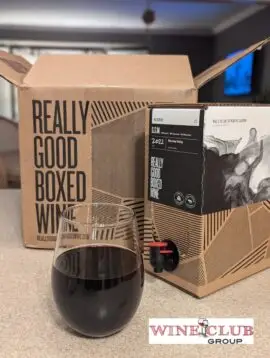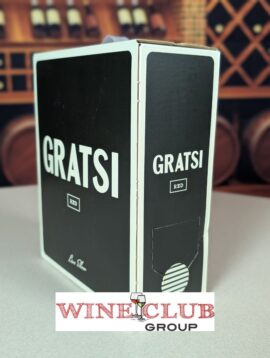A few months ago I was introduced to (and reviewed) Really Good Boxed Wine. I ordered some of their wine and shared my experience ordering and receiving really good boxed wine. Soon thereafter, I learned about another boxed wine called Gratsi Wine and was given some boxes to review.
Reviewing these boxed wines got me thinking more about boxed wine, in general, and how both perception and marketshare have evolved over the years.
Until recently our wine reviews had only been associated only with “bottles”
Since 2012, Tricia and I have been reviewing wine subscriptions, online wine stores and wine gifts. Although we may have had a lot of personal boxed wine experience over the years (I know I have!), we haven't published any of it. Only recently have we begun publishing boxed wine reviews. See our review of Really Good Boxed Wine and our review of Gratsi Wine here!
Really Good Boxed Wine Editor choice
Gratsi Wine Editor choice
After posting my reviews of boxed wine, we've also seen an increase in interest in Really Good Boxed Wine and Gratsi wine, as these reviews have become a big draw for our audience.
So, with my personal renewed intrigue in boxed wine, combined with our audience's interest in finding the best boxed wine, we researched and wrote:
The Ultimate Guide to Buying The Best Boxed Wine Online and In-Store. (Updated September 2025)
In this ultimate guide for buying boxed wine, I'm going to share with you everything from the perception and history of boxed wine to the big players, their market share, their costs & pricing structures, and more.
And of course, I'll share my favorite premium boxed wines that I think are even better.
BTW – I've had so much fun with this boxed wine research. I actually created a whole collection of boxed wine memes made just because of this! (So there is a little comedic bonus at the end of this post to look forward to.)
Introduction: The Reputation Reset
For years, boxed wine carried a reputation for being the cheap stuff. You know, something you’d grab for a dorm party or stash away when budget mattered more than taste. But I'm thinking that image is outdated. Thanks to better packaging technology, improved winemaking, and a growing demand for affordable, eco-friendly options, boxed wine has transformed into a serious contender for everyday drinking and even premium occasions.
Here in our ultimate guide, we’ll explore the history of boxed wine, why its reputation has changed, and what you should really expect when buying it today — from cost per glass and shelf life to how it compares with bottles and which boxed wine brands deliver the best experience. By the end, you’ll know not only why boxed wine deserves a spot at your table, but also where to find the best premium boxed wines online. (Keep coming back, we'll update this post with details as things evolve: updated September 19th 2025)
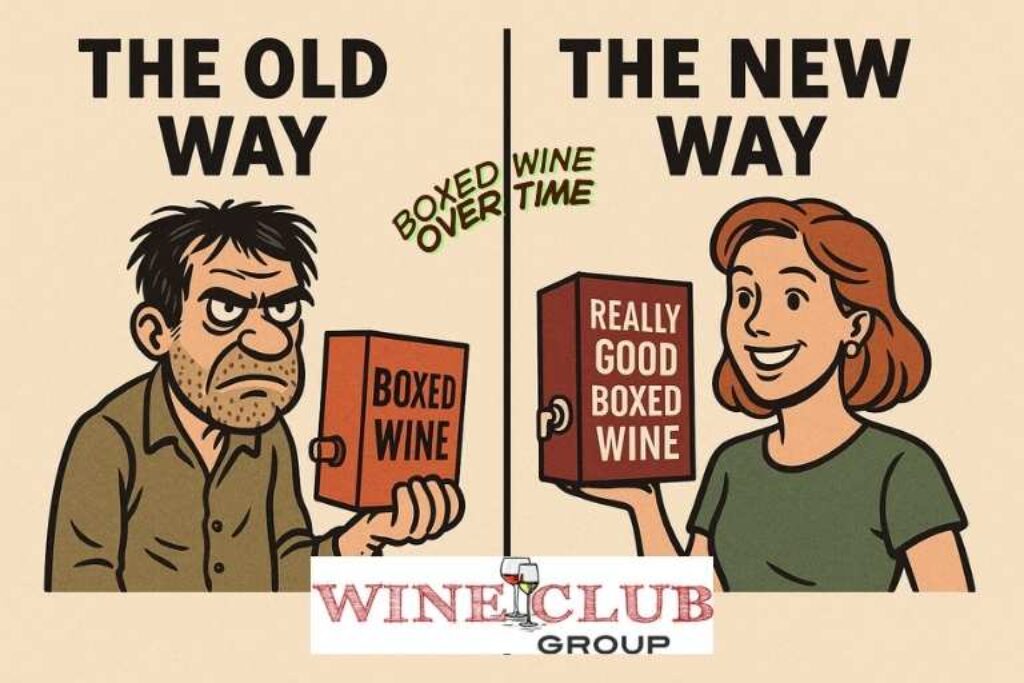
The History of Boxed Wine
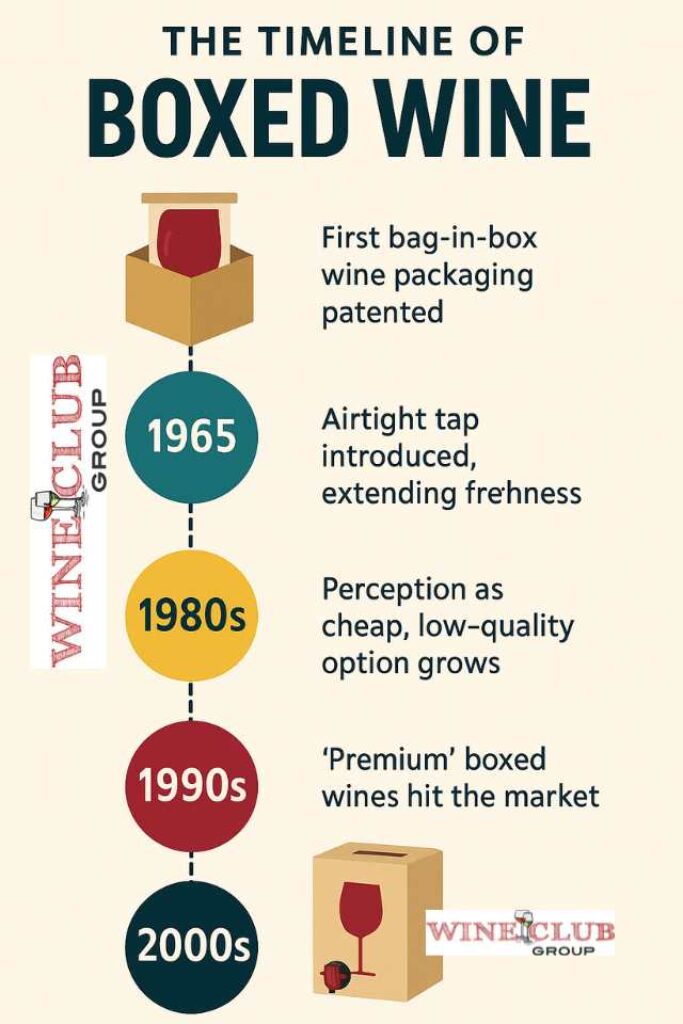
The story of boxed wine starts in the 1960s in Australia, when winemaker Thomas Angove patented a revolutionary idea: packaging wine in a plastic bladder inside a cardboard box. Known as the “wine cask” or “goon bag,” it was practical, lightweight, and much easier to transport than carrying around heavy, fragile glass bottles. Soon after, the innovation spread worldwide, with mass-market brands like Franzia making boxed wine a household name in the United States.
Unfortunately, back then, this convenience came with a tradeoff: quality.
For decades, boxed wine was filled with inexpensive blends, remnant inventory and marketed as a bargain product. That early reputation stuck with me and many other wine lovers, leaving us to dismiss boxed wine as “cheap wine” unworthy of serious attention.
Back in the late 90's early 2000's, when I started exploring boxed wine as an option to traditional bottled wine, I had low expectations. I knew the reputation wasn't so great, but I had heard about strides in boxed wine quality so I wasn't afraid to gamble up to $25 on a box of wine.
Over time, and after trying dozens of different boxed wine brands with varying results (this is the time period in my life that we'll call “research for this blog post”), I found myself coming back to Bota Box and Black Box, time after time, as my go-to wine choices when purchasing boxes of wine. They were always readily available at my local Kroger, Target or Walmart. No wonder they are the top selling boxed wine brands in the United States! (Of course, at the time I did not yet know about Really Good Boxed Wine nor Gratsi wine.)
Just before I started trying boxed wine, the evolution of boxed wine had been dramatic in terms of reputation and technology. Advances in packaging technology kept wine fresh for weeks after opening, while improvements in winemaking mean that boxed wines can taste every bit as good as their bottled counterparts.
In fact, recently several producers have embraced the format for premium boxed wine, offering single-varietal wines and vineyard-specific releases that prove boxed wine can be both high-quality and sophisticated. Notably, Really Good Boxed Wine is a truly premium boxed wine vendor offering amazing single-varietal wines and is my personal #1 favorite boxed wine.
| The Shipping | ||||||
|---|---|---|---|---|---|---|
|
||||||
| Specification | ||||||
|
||||||
Today, boxed wine represents not just convenience but also sustainability, affordability, and depending on the brand purchased, a new way to enjoy wine without compromise — a far cry from its humble beginnings back in the day. (And now, people are less likely to joke about boxed wine's quality. Unless you see our memes below.)
📊 Evolution of Boxed Wine
| Decade | Milestone | Reputation | Notable Brands/Events |
|---|---|---|---|
| 1960s | Invention of the “wine cask” in Australia by Thomas Angove | Novelty packaging, experimental | Angove’s “goon bag” |
| 1970s | Boxed wine spreads internationally; mass-market adoption begins | Seen as cheap & convenient | Franzia launches in U.S. |
| 1980s–1990s | Growth in low-cost blends; focus on volume over quality | Strong “cheap wine” stereotype forms | Franzia, Vella, supermarket brands |
| 2000s | Mid-range players improve packaging and varietals | Slowly gaining acceptance as everyday drinker | Black Box, Bota Box |
| 2010s | Eco-friendly push + modern branding | “Not just cheap” — more eco & lifestyle marketing | Barefoot On Tap, eco campaigns |
| 2020s | Premium boxed wines emerge with vineyard-specific selections | Reputation reset — serious wines in a box | Really Good Boxed Wine, Gratsi, Juliet |
Boxed Wine vs. Bottled Wine
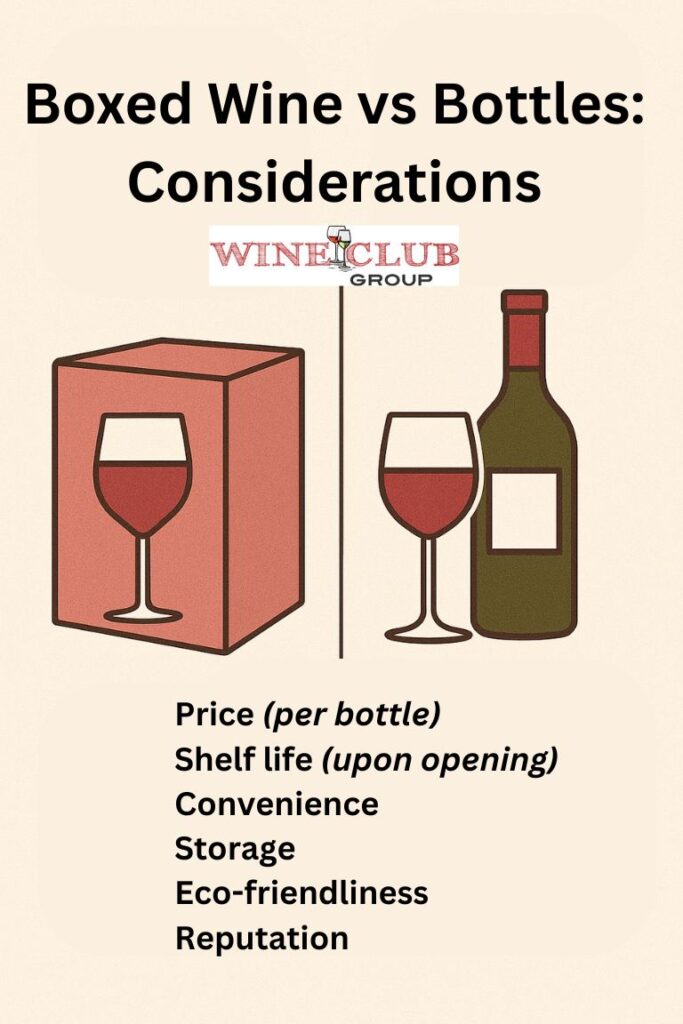
When deciding between boxed wine vs bottled wine, the differences go far beyond packaging. Both formats have their strengths, but understanding how they compare in price, freshness, storage, and eco-friendliness can help you decide which is right for your lifestyle.
📊 Quick Snapshot: Boxed vs. Bottled Wine
| Feature | Boxed Wine | Bottled Wine |
|---|---|---|
| Price (per glass) | Lower on average — often under $2/glass for mid-range brands | Wider range: bargain to luxury; premium bottles can be $10–$20+ per glass |
| Shelf Life (opened) | 4–6 weeks thanks to airtight spout and inner bladder | 3–5 days after opening, even with a stopper |
| Convenience | Lightweight, portable, no corkscrew needed | More formal presentation; standard for restaurants and celebrations |
| Storage | Takes up less space; easy to stack in fridge or pantry | Requires more room; must store upright or sideways for cork integrity |
| Eco-Friendliness | Lower carbon footprint; less glass and lighter shipping weight | Glass is recyclable but energy-intensive to produce and ship |
| Reputation | Once “cheap wine,” now includes premium boxed wine options | Perceived as higher status; centuries of tradition |
💰 Cost Comparison
One of the biggest draws of boxed wine is value. A standard 3L box holds the equivalent of four bottles of wine, where the cheapest of the options are often priced between $18–$25. That means you’re paying about $4-6 per bottle equivalent, or roughly $1–$1.50 per glass –far less than most bottled wine.
Again, this represents the cheap end of the market at your local grocery store, Walmart or Target store. Keep your expectations low when buying boxed wine under $25 a box.

🕒 Freshness & Longevity
Boxed wine has the upper hand once it’s opened. The vacuum-sealed bag prevents oxygen from spoiling the wine, keeping it fresh for up to six weeks. Bottled wine, on the other hand, starts oxidizing as soon as you pull the cork and usually lasts less than a week.
(And by less than a week, I mean: It goes bad almost overnight! So drink up, or roll the dice on sour, vinegar wine tomorrow.)

🌎 Eco & Practical Benefits
Shipping and transporting boxed wine is cheaper and greener, since (1) bottles break and require extra packaging to keep them safe, and (2) cardboard and plastic weigh far less than glass.
Plus, for casual drinkers, parties, camping, or travel, boxed wine’s portability is unbeatable. Bottled wine still wins for formal occasions and cellaring fine vintages, but for everyday drinking, the box makes a lot of sense.
The best boxed wine brands now sell online, offering direct-to-consumer delivery that’s both cost-effective and eco-friendly. (Our favorites are Really Good Boxed Wine and Gratsi Wine.)
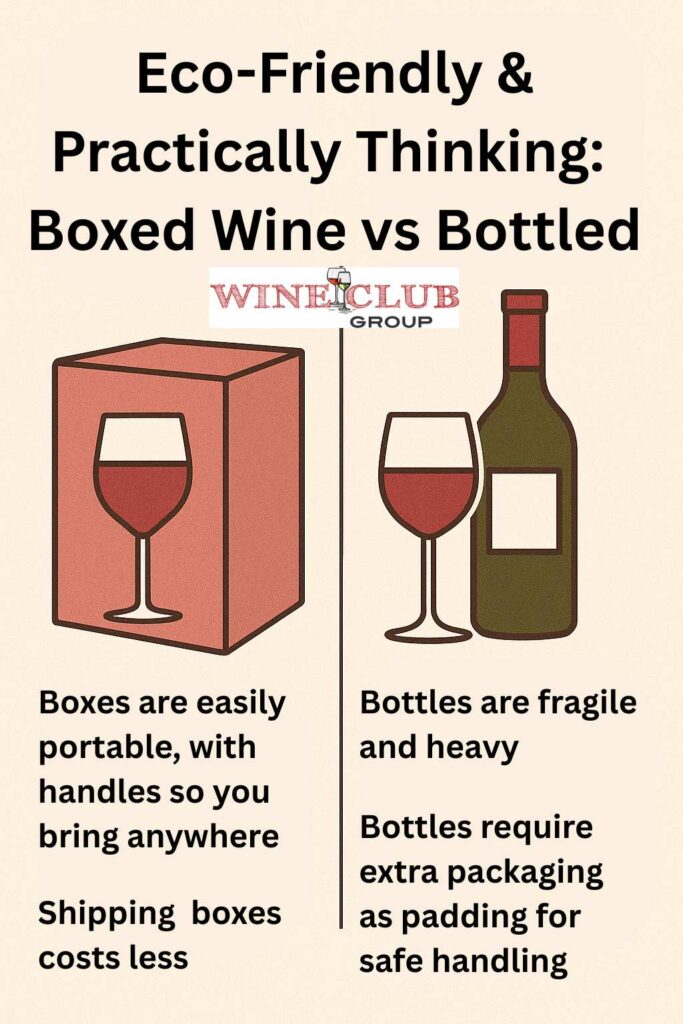
What to Expect When Buying Boxed Wine
If you’re new to boxed wine, you might be surprised by how much variety exists today. From budget-friendly party staples to premium boxed wine crafted from single varietals, the options cover every type of wine drinker. Here’s what you should know before you buy.
With boxed wine, you don't need a corkscrew.
Keep the tools at home. The boxes come with a spout that anyone can open, no corkscrew required. (Nothing beyond the basic functions of opposable thumbs are needed to open a box of wine!)
Although each boxed wine company has its own technology for how you open their boxed wine, they all operate similarly. All boxed wines simply have spigots attached to the bag inside the box. Once you expose the spout (just open the box where indicated — and pull out the spout) you simply unwrap the spout from it's “closed” state. Once the spout is unsealed, you simply depress the button on top of the spout (spigot) to release the flow of wine. And voila! You have wine!
After you open boxed wine, it will stay fresh for weeks, not days.
Whenever I open a bottle of wine, particularly red wine, my rule of thumb is: “drink the whole bottle tonight, because the wine will not be good tomorrow.”
Sure, that may be a bit extreme, as some wines are fine the next day if protected from exposure to oxygen quickly enough, and sufficiently. (I'm sure that sometimes those “vacuum corks” help preserve wine for a day or two.)
The key benefit here is that when you open a box of wine, there is no pressure to over drink — or at least no pressure to drink more than a glass or so. Once you open a box of wine, you can just drink a glass or two at any time, with no pressure to over drink because you “don't want the wine to go to waste”.
And storing your opened boxed wine is easy, too. If you want to chill your white wines, just keep the box in your refrigerator. Or if you prefer red wine (like me), just keep it on the countertop. (How long do you think it will last in your house? For me: a week to ten days — tops.)
Once you go boxed wine, it's hard to go back.
I'm kidding, I still love bottles of wine!
But, there is something to be said about the convenience of having a single glass of wine available any random night of the week — without knowing there are 3 additional glasses of wine that must be consumed before the next evening. Otherwise, your “random night of the week, single glass of wine” just cost you the price of an entire bottle.
With boxed wine, you get what you pay for. (But there are good deals!)
If you get Franzia or another cheap box of 3L or 5L of wine for under $20, what would you expect?
Well, some people like the cheap stuff.
Obviously, based on their sales volume, a LOT of people like cheap Franzia boxed wine. It's popular for a reason! And it can't be just the price that drives all the sales of Franzia: some people (not me) must find it good enough to drink! Plus, it's immediately available at your local grocery store, with no delay for shipping — so it's extra convenient. But, if you want wine that you will actually enjoy, I'd consider Gratsi or Really Good Boxed Wine.
What to Expect to Spend When Buying Boxed Wine
| Factor | Budget Boxed Wine 🥤 | Mid-Range Boxed Wine 🍷 | Premium Boxed Wine 🥂 |
|---|---|---|---|
| Price (3L) | Under $20 | $20–$30 | $40–$70+ |
| Cost per Glass | ~$0.75–$1.25 | ~$1.25–$2.00 | ~$2.50–$4.00+ |
| Shelf Life | 4–6 weeks after opening | 4–6 weeks after opening | 4–6 weeks after opening |
| Taste & Quality | Basic blends, party wines | Reliable varietals, everyday sippers | Vineyard-driven, boutique-quality wines |
| Examples | Franzia, Liberty Creek | Black Box, Bota Box, Barefoot On Tap | Really Good Boxed Wine, Gratsi |
| Best For | Big parties, casual use | Dinner wine, weeknight pours | Wine lovers, gifting, eco-conscious buyers |
💵 Pricing Tiers
- Budget Boxes (under $20 for 3L): Popular mass-market brands like Franzia and Liberty Creek offer unbeatable value — often less than $1 per glass. These are ideal for parties, cooking, or casual sipping.
- Mid-Range ($20–$30 for 3L): Brands like Bota Box and Black Box focus on consistent quality at an affordable price. Expect varietal labeling (Cabernet Sauvignon, Chardonnay, etc.) and approachable flavors.
- Premium ($40–$70 for 3L): Producers such as Really Good Boxed Wine and Gratsi Wine are breaking the stereotype by offering vineyard-driven, small-lot wines in box format. These are designed for wine lovers who want convenience without sacrificing quality.
✅ Quick Takeaway
When buying boxed wine, think of it like shopping for bottled wine: you’ll find a range from everyday drinkers to impressive, premium options. The difference is that with boxes, you often get more wine for less money, longer freshness, and easier storage. And, the best wines in a box are the ones we recommend like Really Good Boxed Wine and Gratsi.
📊 Boxed Wine Pricing Tiers at a Glance
| Tier | Price Range (3L) | Equivalent Bottles | Cost per Glass | Examples | Best For |
|---|---|---|---|---|---|
| Budget | Under $20 | 4 bottles | ~$0.75–$1.25 | Franzia, Liberty Creek | Big parties, casual sipping, cooking wine |
| Mid-Range | $20–$30 | 4 bottles | ~$1.25–$2.00 | Black Box, Bota Box, Barefoot On Tap | Everyday drinking, affordable varietals |
| Premium | $40–$70 | 4 bottles | ~$2.50–$4.00+ | Really Good Boxed Wine, Gratsi Wine | Wine lovers, eco-conscious buyers, gifts |
Our Favorite Boxed Wines Are Only Available Online
The Big Players In Boxed Wine Industry
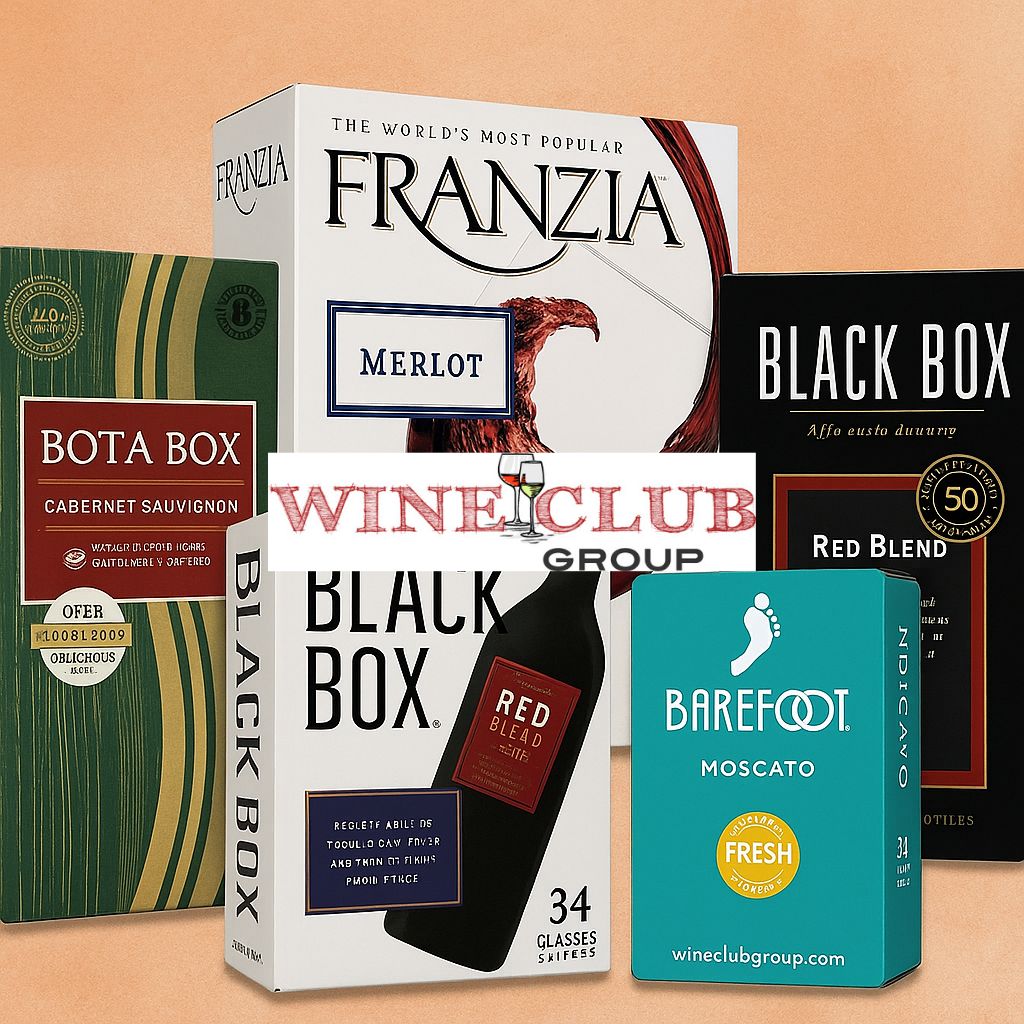
While boutique producers are helping to elevate the category, most people’s first experience with boxed wine brands comes from the big names you can find at nearly every grocery store. Here’s a breakdown of the key players.
🍷 Top 4 National Boxed Wine Picks
| Brand | Product | Size |
|---|---|---|
| Bota Box | Cabernet Sauvignon | 3 L |
| Franzia | Merlot | 5 L |
| Black Box | Red Blend | 3 L |
| Barefoot On Tap | Moscato or Cabernet | 3 L |
1. Bota Box – Cabernet Sauvignon (3 L)
Widely regarded as America’s leading premium boxed wine, Bota Box Cabernet delivers balanced dark fruit with consistent quality.
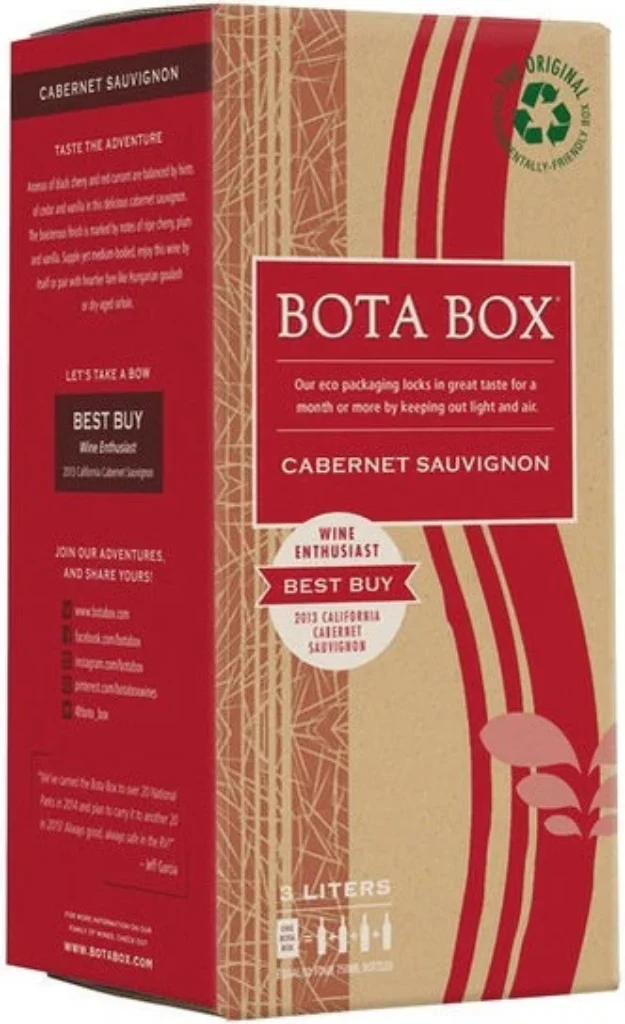
Bota Box has become the go-to choice for wine drinkers who want the convenience and eco-friendliness of boxed wine without sacrificing quality. Launched by Delicato Family Vineyards, Bota Box positioned itself as a premium boxed wine option — and it worked. The brand has exploded in popularity over the last decade, now boasting widespread distribution in grocery chains, wine retailers, and even boutique liquor stores across the U.S. It’s frequently praised by wine publications and blind taste tests as one of the best bang-for-your-buck boxed wines on the market.
Each 3-liter box (about 4 bottles' worth) retails around $18–$24, depending on location and variety, and the wine stays fresh for up to 30 days after opening. Bota Box offers a wide selection of varietals, with Cabernet Sauvignon, Pinot Grigio, and RedVolution (a red blend) standing out as fan favorites. Many drinkers also enjoy Nighthawk sub-labels like Nighthawk Black, which target more full-bodied, bold wine fans. Pros of Bota Box include its surprising complexity, consistent taste, and eco-conscious packaging. If there’s a con, it’s that wine snobs still raise an eyebrow at boxed formats — but for everyday wine lovers who care about quality, value, and convenience, Bota Box has truly redefined what boxed wine can be.
🍷 Bota Box
- Price Range: $20–$25 for a 3L box (~4 bottles).
- Cost per Glass: ~$1.25–$1.50.
- What to Expect: Known for its eco-friendly packaging and wide availability, Bota Box appeals to environmentally conscious buyers. Flavors are fruit-forward and easy to enjoy, making it a good option for casual wine lovers and picnics.
2. Franzia – Merlot (5 L)
Franzia is a classic, budget-friendly boxed wine known for its affordability and mass appeal.
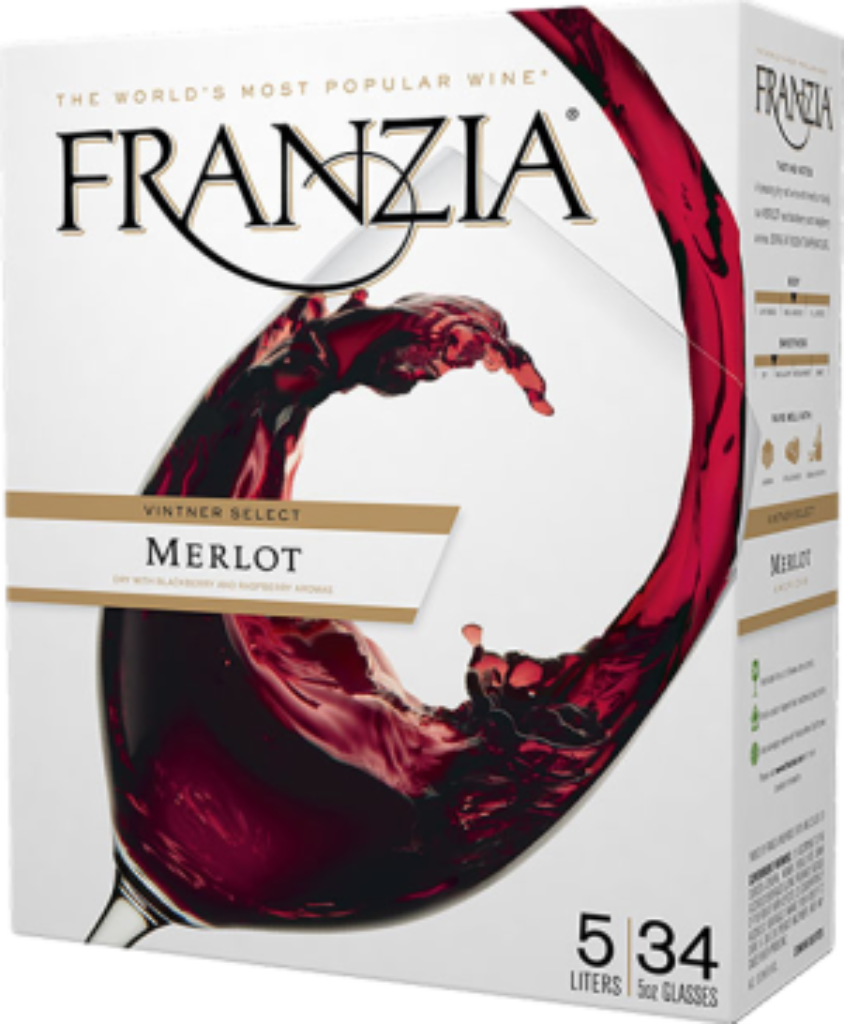
Franzia is arguably the most recognizable boxed wine brand in America, often credited with popularizing the format among budget-conscious wine drinkers. Launched in the 1930s and rebranded in the 1980s into its current boxed format, Franzia has become a cultural staple — especially in college circles, casual parties, and family gatherings. Its appeal lies in its massive 5-liter size (equivalent to over 6 bottles of wine), unbeatable price point (usually $15–$20 per box), and easy-pour spout, making it perfect for entertaining on a budget.
Franzia’s most popular varieties include Chillable Red, Sunset Blush, and White Zinfandel, with Cabernet Sauvignon and Merlot holding down the red wine crowd. While connoisseurs won’t mistake it for fine wine, fans appreciate its consistent taste, low cost per glass, and long shelf life once opened (up to six weeks refrigerated). On the downside, Franzia is known for its lower alcohol content and lighter-bodied flavor profile, which can feel watered down to more experienced wine drinkers. Still, for those looking for maximum volume, party-friendly packaging, and nostalgic value, Franzia remains king of the box.
🍷 Franzia
- Price Range: $15–$20 for a 5L box (~6.5 bottles).
- Cost per Glass: As low as $0.50.
- What to Expect: Franzia is the original U.S. household name in boxed wine and still dominates in terms of sales volume. It’s light, approachable, and perfect for budget buyers and large gatherings. Quality varies by varietal, but it's hard to find cheaper wine.
3. Black Box – Red Blend (3 L)
Black Box is a mid-tier favorite praised for its juicy, smooth blend—a solid choice both in reviews and blind tastings.
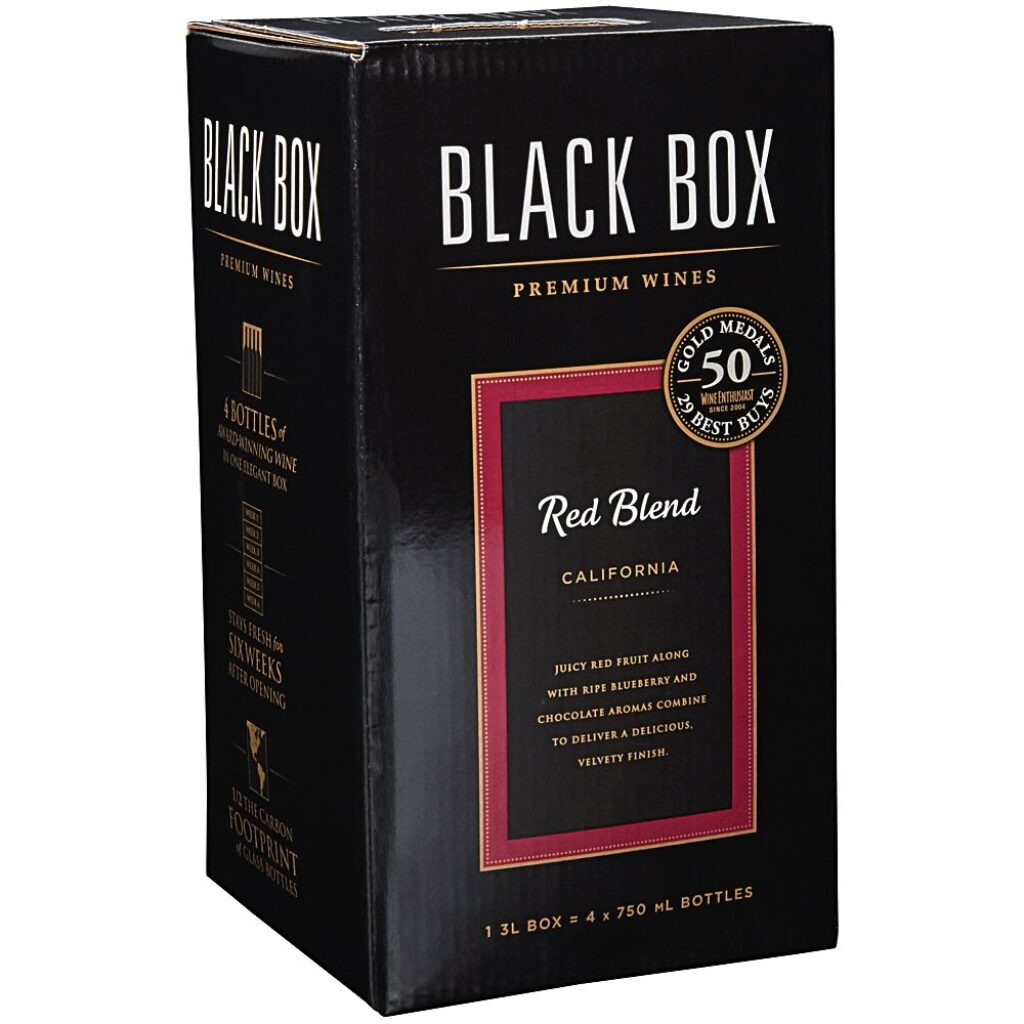
Black Box is one of the most well-regarded boxed wine brands in the U.S., positioned squarely between budget options like Franzia and premium contenders like Bota Box. Known for its sleek packaging and surprisingly solid wine, Black Box has won over both casual wine drinkers and budget-conscious enthusiasts who still want a hint of sophistication in their glass. Each 3-liter box (equivalent to 4 standard bottles) generally sells for $19–$25, and the wine stays fresh for up to a month once opened.
Popular varieties include the Red Blend, Cabernet Sauvignon, Chardonnay, and Pinot Grigio. Among these, the Red Blend and Cabernet often receive high marks in blind tastings, praised for their fuller body and balance compared to competitors in the same price range. Black Box wines tend to be fruit-forward and smooth, with enough structure to appeal to wine drinkers looking for more than just sweetness. Pros include their consistent quality, availability across most U.S. retailers, and a more “grown-up” boxed wine experience. The cons? While good for the category, these wines still aren’t complex enough to satisfy high-end wine drinkers—but for everyday sipping, Black Box remains a smart and stylish choice.
🍷 Black Box
- Price Range: $20–$25 for a 3L box (~4 bottles).
- Cost per Glass: ~$1.25–$1.50.
- What to Expect: Often cited as one of the best values in boxed wine, Black Box offers varietals like Cabernet Sauvignon, Merlot, Chardonnay, and Pinot Grigio. It consistently outperforms expectations for its price and is a favorite for everyday drinking.
4. Barefoot On Tap – Moscato or Cabernet (3 L)
Barefoot is a well known budget brand of wine highlighting convenience and fresh flavors.
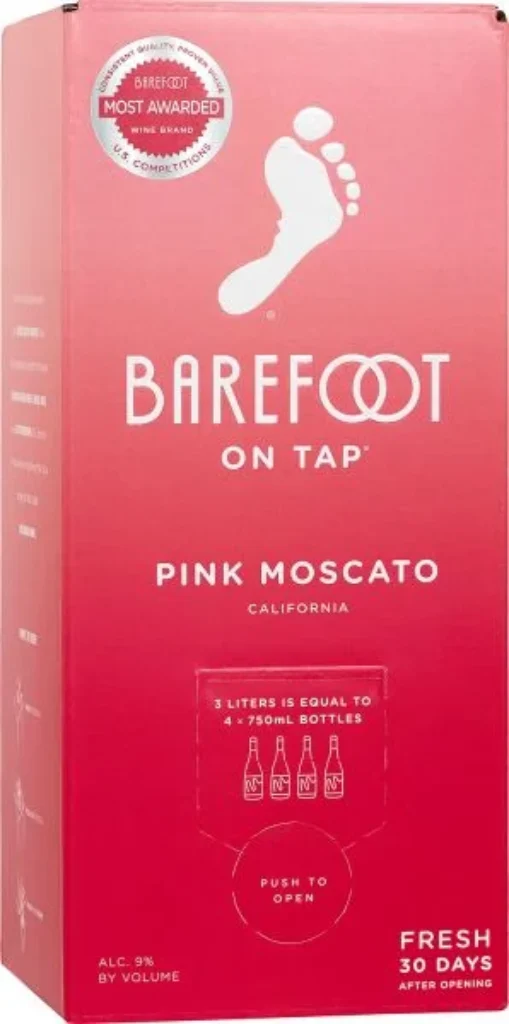
Barefoot On Tap is the boxed wine extension of one of America’s most approachable and best-selling wine brands: Barefoot. Known for its fun, unpretentious image and wide selection of fruit-forward wines, Barefoot launched its boxed format to give fans a more convenient way to enjoy their favorite varietals. Each 3-liter box (equal to 4 bottles) typically sells for $16–$22, making it both affordable and widely accessible at supermarkets, drugstores, and big box retailers nationwide.
Popular varieties include Moscato, Pinot Grigio, Cabernet Sauvignon, and Rosé—all of which echo Barefoot’s signature style: sweet-leaning, easy-drinking, and crowd-pleasing. These wines are especially popular among younger drinkers, casual wine fans, and anyone looking for a laid-back pour that’s easy on the wallet and the palate. The biggest pros of Barefoot On Tap are its cheerful branding, sweet and fruity profiles, and its grab-and-go value. However, it’s not made for those seeking structure, tannins, or complexity—it’s wine for pool parties, BBQs, and Tuesday nights. If you like your wine fun, accessible, and ready to share, Barefoot On Tap fits the bill.
🍷 Barefoot On Tap
- Price Range: $20–$25 for a 3L box (~4 bottles).
- Cost per Glass: ~$1.25–$1.50.
- What to Expect: A boxed extension of the popular Barefoot brand, On Tap brings its approachable, sweet-leaning style to the box format. It’s widely available and works well for entry-level drinkers who enjoy sweeter, fruitier wines.
Current Prices of Big Brand Boxed Wines Available Locally, Nationwide
These mainstream boxed wine brands are designed to maximize value and accessibility. They’re not trying to compete with boutique wineries but instead offer reliable, affordable options for everyday enjoyment. For many wine lovers, these boxes are the gateway to discovering the convenience and quality of the format — and often the first step toward exploring premium boxed wine brands.
PRICE UPDATES FOR 2025: Recently, I took some photos of the following big brand box wine display at my local Kroger.
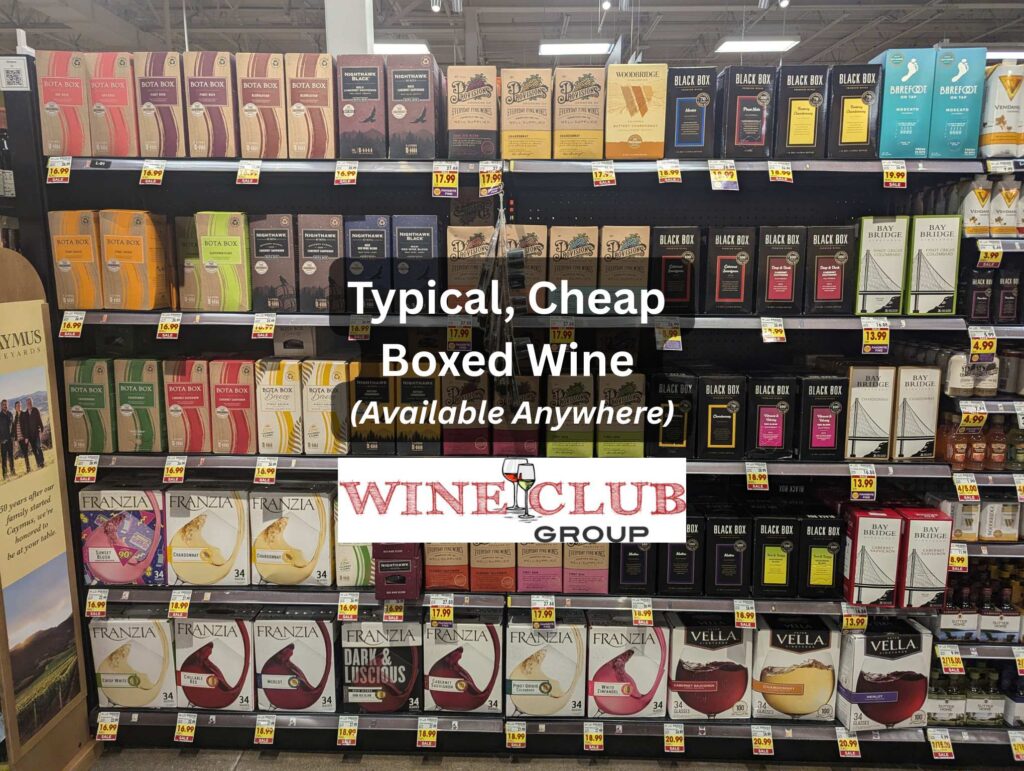
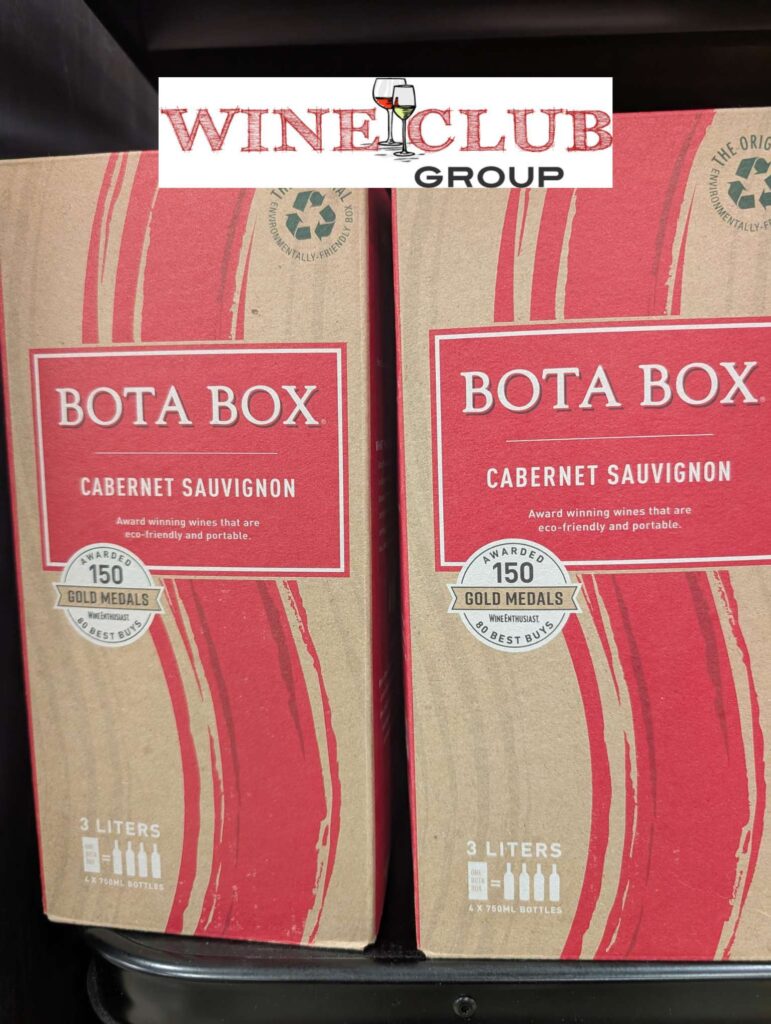


Boxed Wine Brand Showdown: Which One Fits Your Style?
| Brand | Vibe | Top Varietals | Typical Price (3–5L) | Cost per glass | Best For |
|---|---|---|---|---|---|
| Franzia | Iconic, Casual, Budget | Chillable Red, Sunset Blush, White Zinfandel, Merlot | $15–$20 (5L) | ~$0.50 | Parties, bbq, college nostalgia Budget buyers, large parties, casual sipping |
| Bota Box | Eco-smart, Quality-Focused | Cabernet Sauvignon, RedVolution, Pinot Grigio | $18–$24 (3L) | ~$1.25 –$1.50 | Everyday wine lovers, eco-conscious fans Eco-conscious drinkers, picnics, casual occasions |
| Barefoot On Tap | Fun, Fruity, Sweet-leaning | Moscato, Rosé, Pinot Grigio, Cabernet Sauvignon | $16–$22 (3L) | ~$1.25 –$1.50 | Pool parties, casual sippers, sweet wine fans Entry-level drinkers, sweeter fruit-forward wines |
| Black Box | Smooth, Stylish, Mid-tier | Red Blend, Cabernet, Chardonnay, Pinot Grigio | $19–$25 (3L) | ~$1.25 –$1.50 | Weeknight sipping, budget-conscious hosts |
✨ Summary:
- Want a big box for a party and don't care what they drink? Go with Franzia
- Need an everyday wine that’s eco-conscious and reliable? Try Bota Box.
- Love sweet, fruity wines and fun branding? Go for Barefoot On Tap.
- Prefer something smooth and slightly more refined? Black Box is your pick.
These big box brands are widely available, so if you need something local, those are the choices and those are my suggestions.
✨ Better Options:
- Want a convenient box for a party that won't break the bank? Go with Gratsi
- Need a wine that is reliably delicious but costs a couple dollars more? Try Really Good Boxed Wine.
Really Good Boxed Wine Editor choice
Gratsi Wine Editor choice
What big brand boxed wines sell the most?
The marketshare of these big brand box wine companies are generally publicly available, so the numbers I found were readily available. We had to make some estimations to make things simple, but the clear market leader is Franzia.
In order to compare sales, there are two different ways to do so:
- Compare by cases sold
- Compare by dollar amount of sales
Since Franzia is so cheap, it would explain why they sell so much volume. Then, analyze their market share based on the amount of dollars generated from those sales – and although Franzia is still in first place compared to other brands individually, their low price point affects their rankings against their competitors when it comes to money generated from their wine sales.
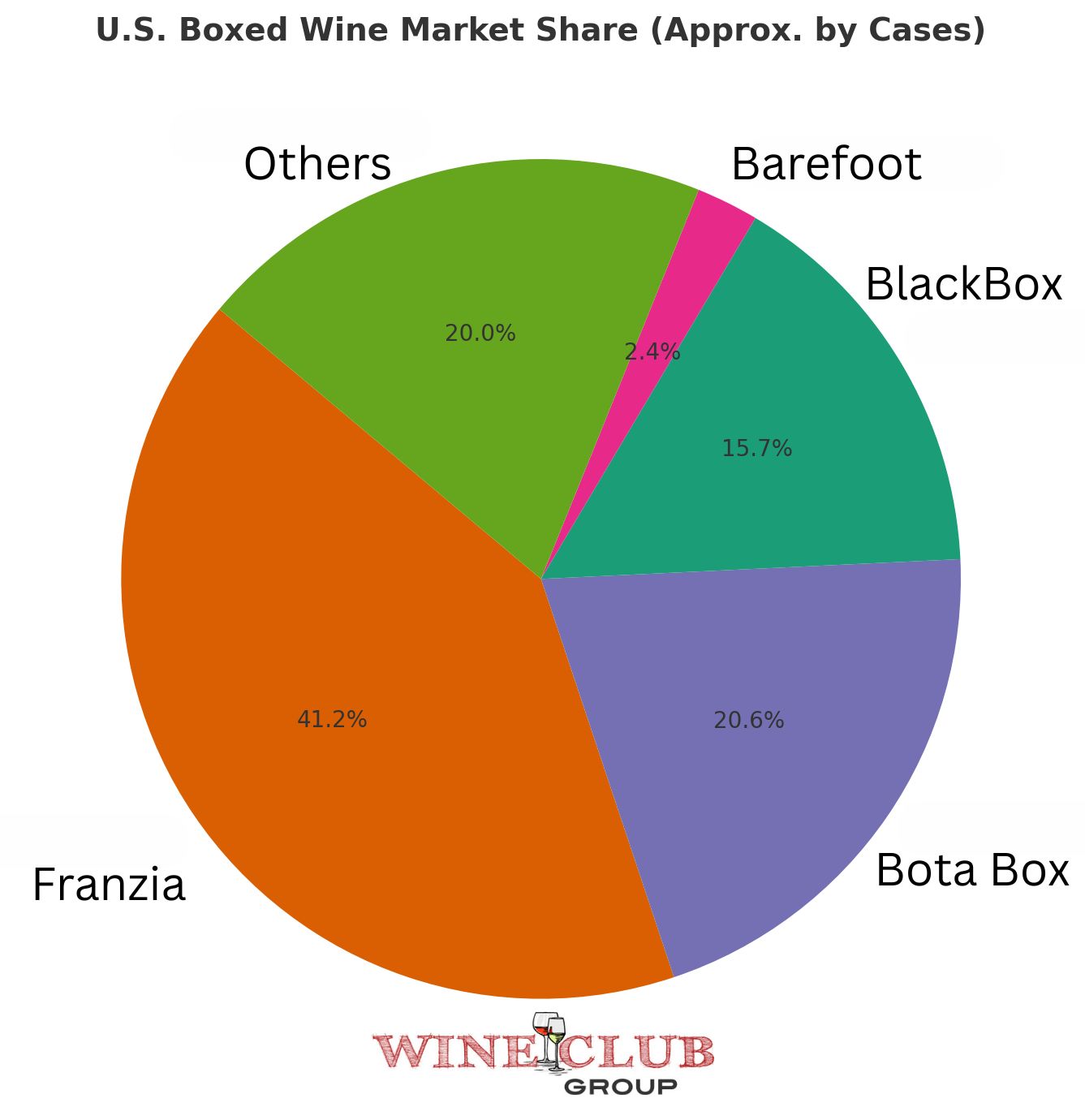
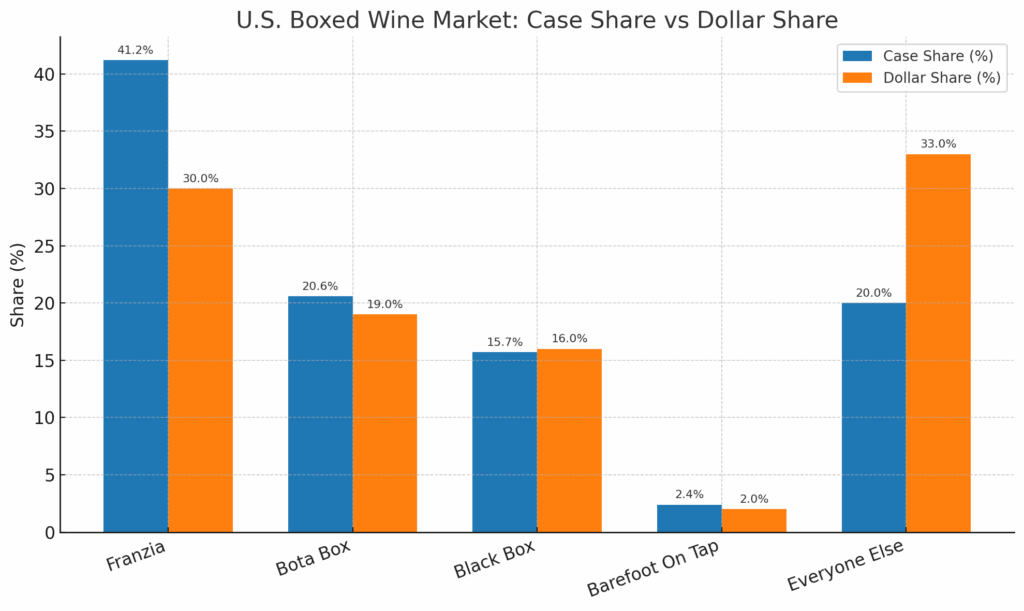
| Brand | Est. Cases (M, 9L equiv.) | Est. Avg. $/3L Box | Dollar Sales (Est. $M) | Case Share % | Dollar Share % |
|---|---|---|---|---|---|
| Franzia | 22.0 | ~$18 | ~$1,320 | 41% | ~30% |
| Bota Box | 11.0 | ~$23 | ~$840 | 21% | ~19% |
| Black Box | 8.4 | ~$25 | ~$700 | 16% | ~16% |
| Barefoot On Tap | 1.3 | ~$20 | ~$87 | 2% | ~2% |
| Everyone Else | 10.7 | ~$30 (weighted higher, includes premium DTC) | ~$1,070 | 20% | ~33% |
| Total | ~53.4 | — | ~$4,017 | 100% | 100% |
What the estimates are based on (by brand)
- Franzia: ~22M 9L cases in the U.S., the largest boxed brand by volume. Shanken News Daily
- Bota Box: ~11M 9L cases in the U.S. (2023/2024 timeframe). Market Watch
- Black Box: ~8.4M 9L cases in the U.S. (2023/2024 timeframe). Market Watch
- Barefoot On Tap: launched to ~1.2M cases in 2019; it dipped slightly in 2021 per Impact/Market Watch coverage. I’ve modeled ~1.3M as a conservative current proxy. Shanken News Daily+1
- Total category proxy: I used 53.4M cases as a baseline (Impact Databank: top 7 boxed brands total in 2020). It’s a reasonable anchor for a directional share view, though exact totals vary by year. Market Watch
Premium & Boutique Boxed Wines
While mainstream brands dominate grocery store shelves, forward thinking winemakers have been redefining what boxed wine can be for the last decade or so. These producers focus on vineyard-driven, small-batch wines packaged in eco-friendly boxes — combining premium quality with the convenience and freshness of the format.
Our favorites are Really Good Boxed Wine and Gratsi Wine.
🍷 Really Good Boxed Wine
- Price Range: $65–$70 for a 3L box (~4 bottles).
- Cost per Glass: ~$4.00.
- What Sets It Apart: True to its name, Really Good Boxed Wine is shaking up the industry by offering premium varietals like Cabernet Sauvignon, Chardonnay, and Rosé in box format. Unlike mass-market brands, these wines come from single vineyards and are crafted with the same care you’d expect from boutique bottled wines.
- Best For: Wine lovers who want exceptional quality without the markup of bottled premiums.
- Where to Buy: Available online for direct-to-consumer delivery. 👉 [Click here to use our affiliate link and buy really good boxed wine]
| The Shipping | ||||||
|---|---|---|---|---|---|---|
|
||||||
| Specification | ||||||
|
||||||
🍷 Gratsi Wine
- Price Range: ~$50–$60 for a 3L box (~4 bottles).
- Cost per Glass: ~$3.00.
- What Sets It Apart: Marketed as “wine for the modern table,” Gratsi emphasizes clean, low-intervention winemaking and eco-friendly packaging. With offerings like Old Country Red and Mediterranean White, Gratsi leans into a European-style drinking experience.
- Best For: Eco-conscious buyers and adventurous wine drinkers looking for something beyond the grocery store.
- Where to Buy: Direct-to-consumer shipping available. 👉 [Use our Affiliate Link Here]
| The Shipping | ||||
|---|---|---|---|---|
|
||||
| Specification | ||||
|
||||
Blind Taste Testing Boxed Wines
In preparation for this blog post, I recently purchased Bota Box and Black Box wines so I could compare them to the Gratsi Wine that I had from a recent review. Unfortunately, I had already consumed all of the delicious Really Good Boxed Wine (my #1 favorite boxed wine) — so I couldn't include it during this live blind taste test.
The winner was clear: Gratsi won in this blind taste test against Bota Box and Black Box.
The black box cabernet was nice, but it was still very “thick” in its vanilla flavors. It just seems so extra and unnecessarily heavy. The Bota Box was easier to drink, a little more “comfortable”, and if I had choose, Bota Box wins between Bota Box and Black Box.
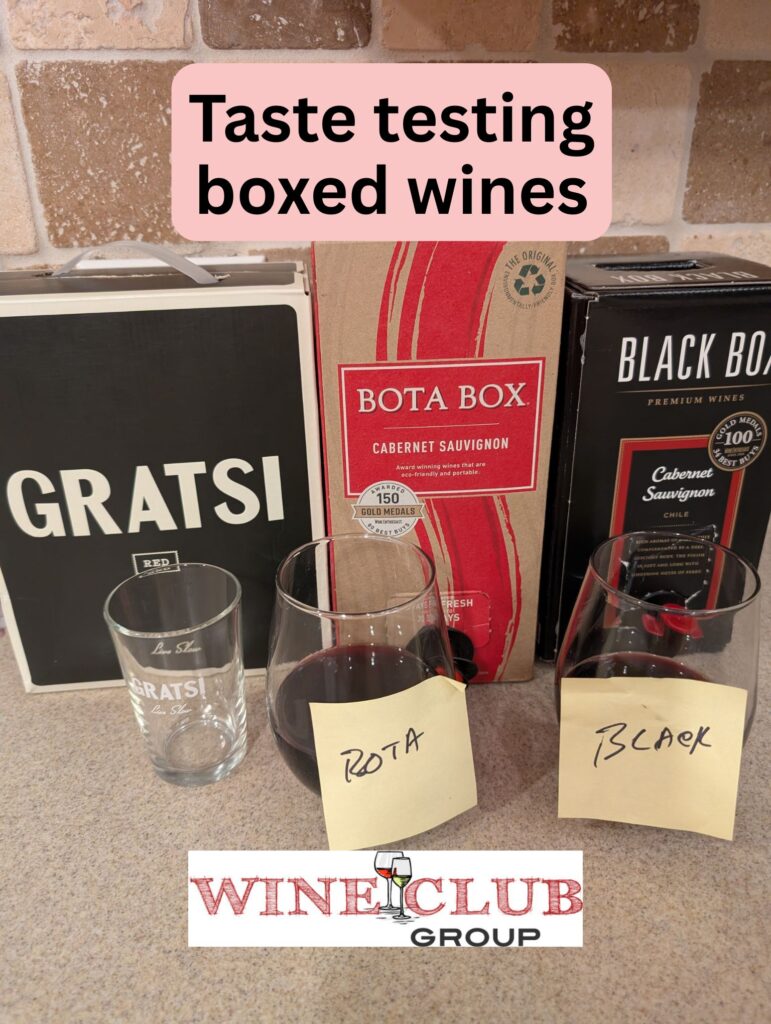
- Have delicious wine you KNOW that you love available
- Drink as little or as much as you want — the wine stays fresh for up to 6 weeks
- Excellent for entertaining and providing luxury wine to your guests
- FREE SHIPPING
- As a small batch producer of quality wines, they have limited quantity. When they're sold out, you have to wait.
- Although prices are half of those for similar quality wine, it's still not cheap. ($70 a box breaks down to $17.50 a bottle)
- Delicious Red Blend. Smooth, dry, medium-bodied, and fruit-forward—reminiscent of an Italian table wine but built on Bordeaux grapes
- Surprisingly Good White & Rosé. Crisp, clean, and citrusy white; light, dry, and refreshing rosé—great for warm weather and poolside sipping.
- High-Quality Packaging & Branding. Simple, minimalistic boxes with a relaxed Mediterranean aesthetic that reinforces their “Live Slow” brand vibe
- Free Bacaro Glasses (with 2+ boxes). Stylish and nostalgic—etched with Gratsi branding and a cool, casual alternative to stemware.
- Great Value by the Box. Wines average as low as $8.50 per bottle when ordering 4 boxes with free shipping.
- Flexible Ordering. One-time purchase or discounted subscription with no long-term commitment required.
- Limited State Availability Gratsi cannot ship to AK, AR, DE, HI, MS, NJ, RI, SD, UT, or WV.
- Not a Traditional Wine Club. Lacks rotating selections from different wineries or personalized curation you might find in other wine-of-the-month clubs.
- Only Three Wines Available. Red, White, and Rosé are all great—but adventurous drinkers may want more variety or new releases.
- Adult Signature Required for Delivery. May be inconvenient if someone 21+ isn’t home during delivery hours (although pickup locations help).
- Boxed Wine Format May Deter Some Buyers. Despite high quality, boxed format can still carry a stigma for those used to bottles.
📌 Quick Takeaway
Premium boxed wines prove the format isn’t just about value, it’s about quality, sustainability, and convenience. For those who want wine that tastes as good as bottles but with the freshness and eco-benefits of a box, Really Good Boxed Wine and Gratsi Wine are leading the way.
📊 Premium & Boutique Boxed Wines at a Glance
| Brand | Box Size | Price Range | Cost per Glass | Best For |
|---|---|---|---|---|
| Really Good Boxed Wine | 3L (~4 bottles) | $65–$70 | ~$4.00 | Wine lovers seeking premium quality and vineyard wines |
| Gratsi Wine | 3L (~4 bottles) | $50–$60 | ~$3.00 | Eco-conscious buyers, adventurous palates |
Who Should Try Boxed Wine?
Not every wine format fits every lifestyle, and that’s exactly where boxed wine shines. With its range of price points and styles, there’s a box for just about everyone. Here’s who will get the most out of it.
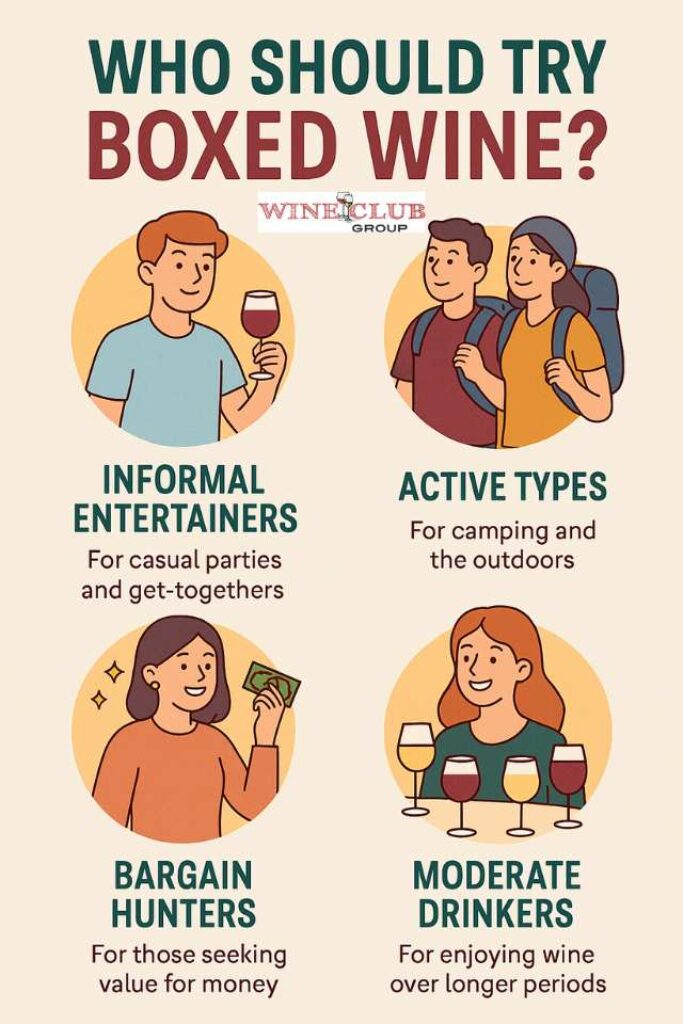
🎉 Party Hosts & Entertainers
If you’re throwing a party, boxed wine is a no-brainer. A single 5L box of Franzia can serve over 30 glasses of wine, making it one of the most affordable and convenient options for large gatherings. No corks, no wasted bottles; you get a steady pour for every guest. (And they can serve themselves!)
🏡 Casual Everyday Drinkers
For those who enjoy a glass of wine with dinner a few nights a week, mid-range brands like Black Box or Bota Box are perfect — but I strongly prefer Really Good Boxed Wine and Gratsi Wine. They strike the balance between price and quality, and their 4-week freshness window means you can pour a glass anytime without worrying about finishing a bottle.
🌎 Eco-Conscious Buyers
Boxed wine has a significantly lower carbon footprint compared to bottled wine, thanks to lighter packaging and reduced shipping costs. Brands like Gratsi Wine and Bota Box highlight this sustainability benefit, making them appealing to those who want to reduce waste without sacrificing flavor.
🍷 Wine Lovers Seeking Quality
Premium producers like Really Good Boxed Wine are redefining what’s possible in boxed wine. For those who love rich varietals, vineyard-driven selections, or are simply curious about the evolution of wine packaging, these boxes prove that you don’t need a cork and bottle to enjoy exceptional wine.
📌 Quick Takeaway
Whether you’re stocking up for a party, sipping a glass after work, or looking for eco-friendly options, boxed wine offers something for everyone. The key is knowing which brands and tiers match your needs. For me, it is NOT Franzia, but I know plenty of people who would like it. That’s what makes boxed wines one of the most versatile wine categories today.
When Boxed Wine is Better Than Bottled
Even the most traditional wine drinkers will admit there are times when boxed wine outshines bottled wine. Thanks to its freshness, portability, and value, the box is sometimes the smarter choice. Here are a few occasions where boxed wine comes out on top:
🎉 Large Gatherings & Parties
- Why boxed wins: More wine, less waste. A single 3L box is the same as 4 bottles of wine, and larger 5L box serves 30+ glasses, making them ideal for weddings, reunions, or backyard barbecues.
- Good picks: Franzia for sheer affordability, or Black Box for a little step up in quality.
- Best picks: Really Good Boxed Wine shows you care about the quality in the glass, or Gratsi Wine for approachable chill vibe wine that costs a little less.
🏞️ Outdoor Adventures
- Why boxed wins: No heavy glass, no corkscrew needed, and the box is easier to transport. Perfect for camping, picnics, beach trips, or tailgating.
- Good picks: Bota Box, known for eco-friendly packaging and portability.
- Best picks: Really Good Boxed Wine is delicious in any setting, or Gratsi Wine for their chill vibe wine that costs a little less.
🕒 Casual Weeknight Glasses
- Why boxed wins: The extended shelf life (up to 6 weeks after opening) means you can pour a single glass without worrying about wasting a whole bottle.
- Good picks: Black Box or Gratsi Wine — reliable quality, perfect for sipping a couple nights per week.
- Best picks: Really Good Boxed Wine steps up your weeknights after a hard day, or Gratsi Wine has those fun glasses and a relaxed vibe that would certainly make your evening better.
🌎 Eco-Friendly Choices
- Why boxed wins: Lighter packaging means a lower carbon footprint and easier shipping. If you want to reduce waste while still enjoying great wine, the box is greener.
- Best picks: Really Good Boxed Wine and Gratsi Wine have impressive eco-friendly policies and systems.
🎁 Casual Gifting
- Why boxed wins: Not every gift needs to be a $40+ bottle. A well-chosen mid-range or boutique boxed wine makes for a unique and thoughtful gift that stands out.
- Best picks: Really Good Boxed Wine for premium wines and Gratsi for a chill vibe — and the included glasses are a nice bonus as a gift!
📌 Quick Takeaway
Bottled wine will always have its place for fine dining, cellaring, or traditional gifting. But for parties, casual sipping, eco-friendly lifestyles, and everyday value, boxed wine is the better choice — hands down.
Boxed Wine Memes & Fun
Let’s be honest — part of the charm of boxed wine is its reputation for being fun, approachable, and sometimes a little over the top. While the category has grown into serious territory with premium options, the internet has fully embraced the humor that comes with pouring wine out of a spout.
🤣 Boxed Wine Memes

I have to admit, I really have enjoyed making these meme stickers and graphics!
From “slap the bag” jokes to endless comparisons between boxed and bottled wine, memes have helped boxed wine reclaim its place in pop culture. They poke fun at the old stereotypes while celebrating the convenience and affordability of the format. Sharing a good boxed wine meme is practically a rite of passage for anyone who’s ever brought one to a party.
Here are a few that I made! (This blog post inspired a lot of creativity and fun!)

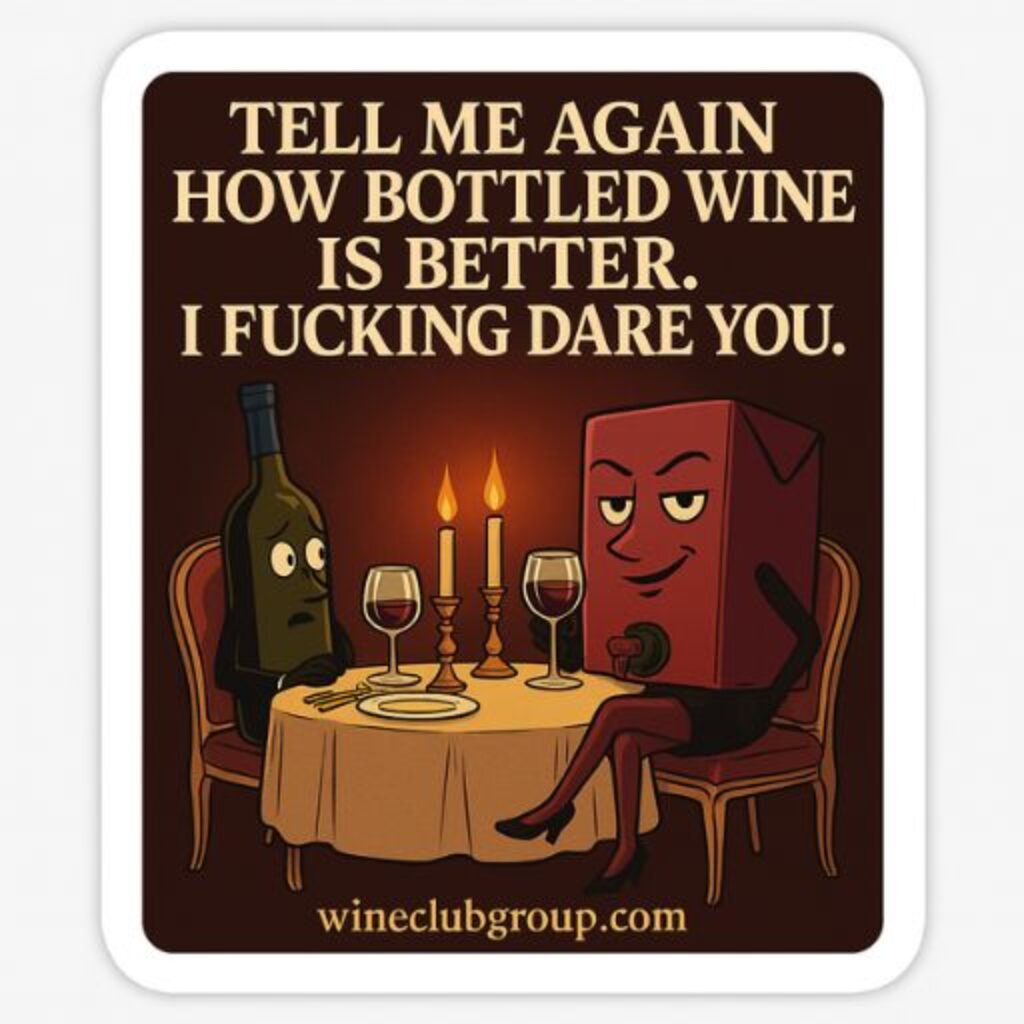
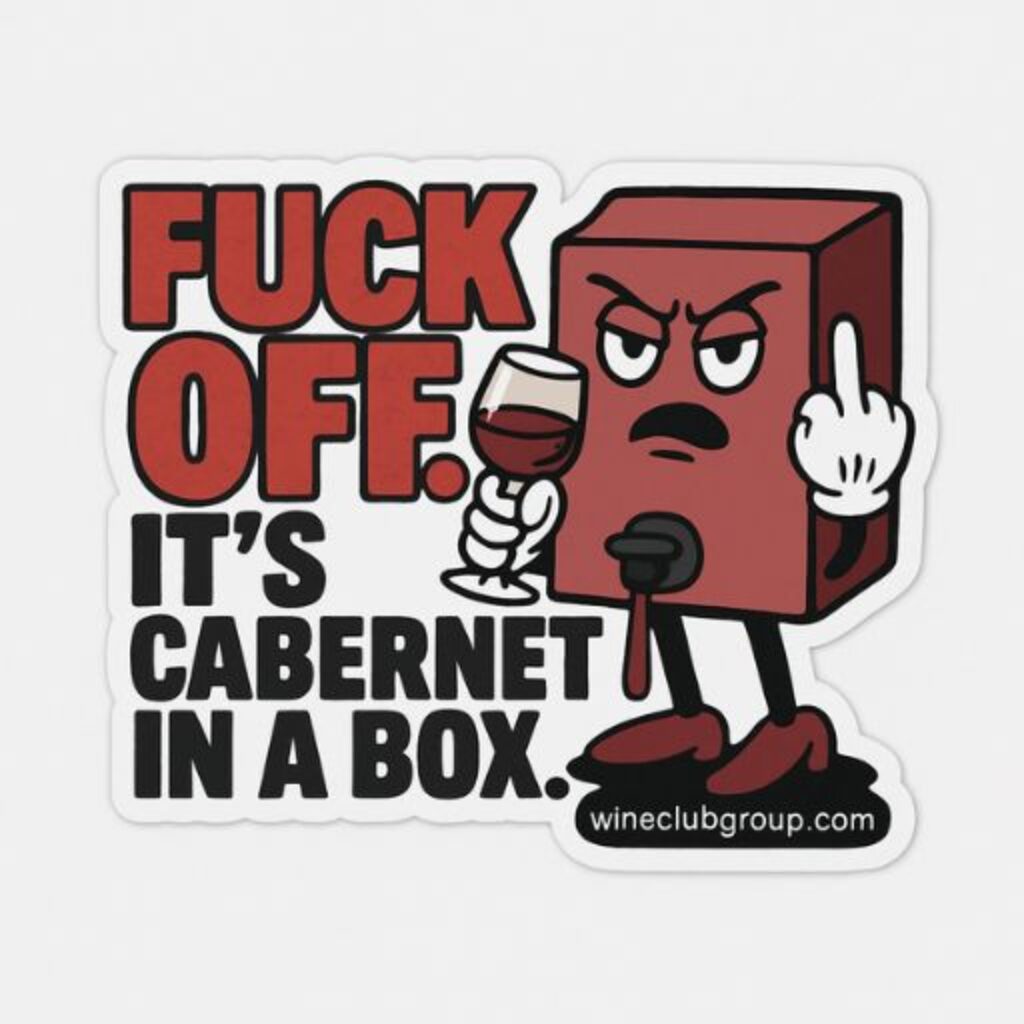
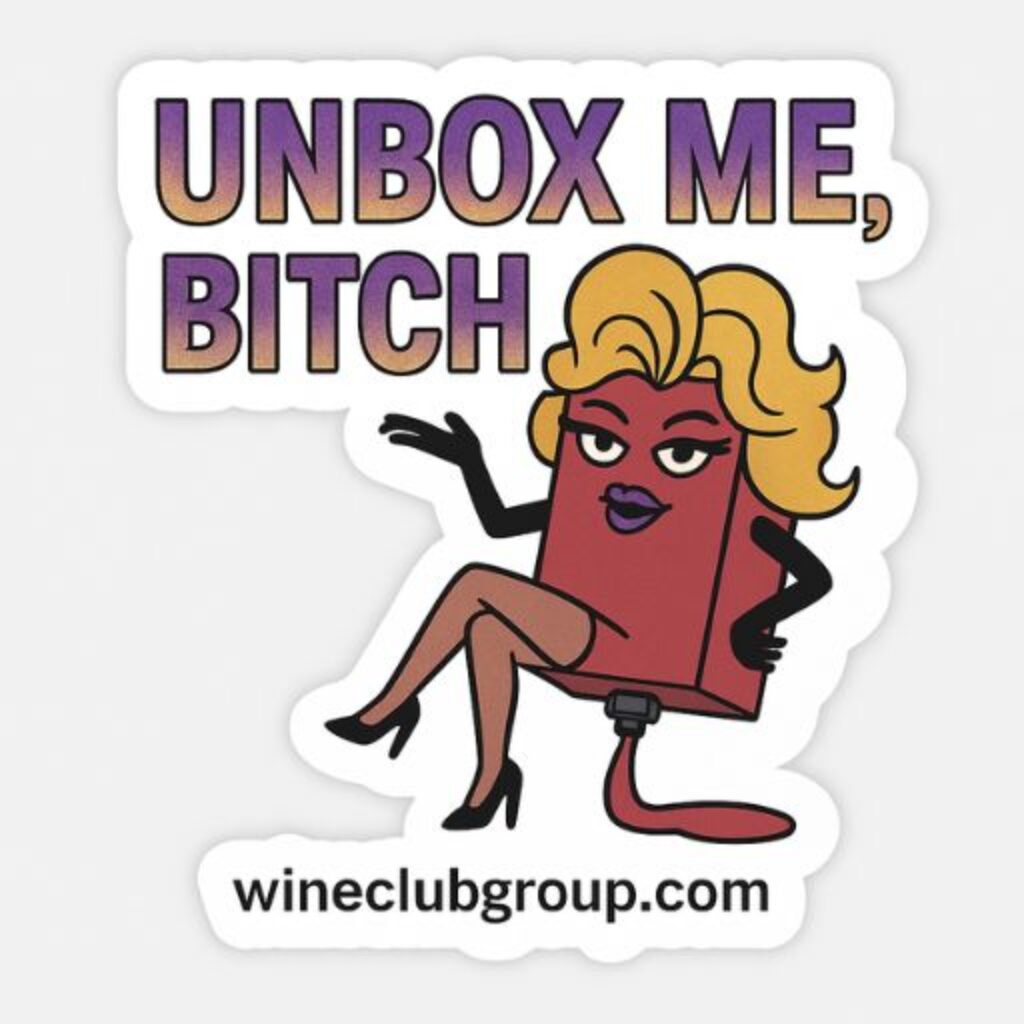
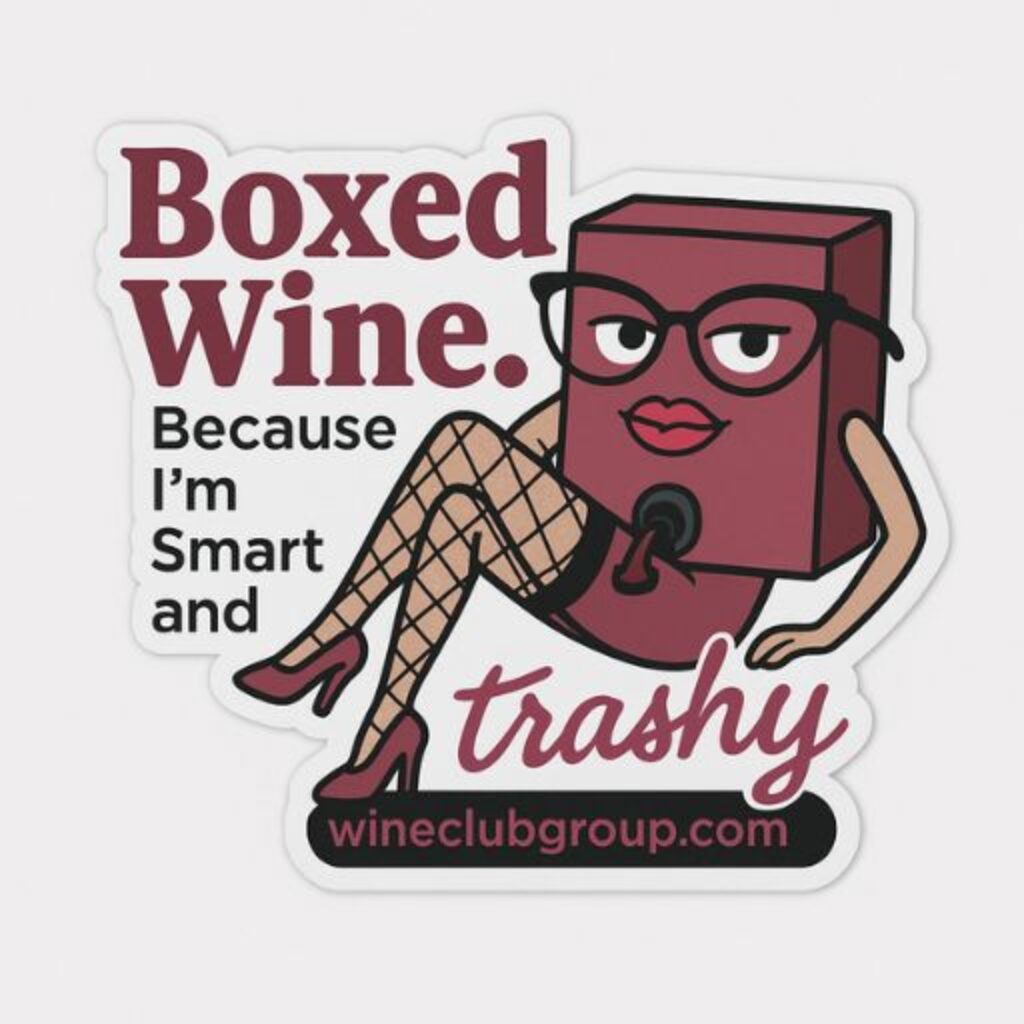
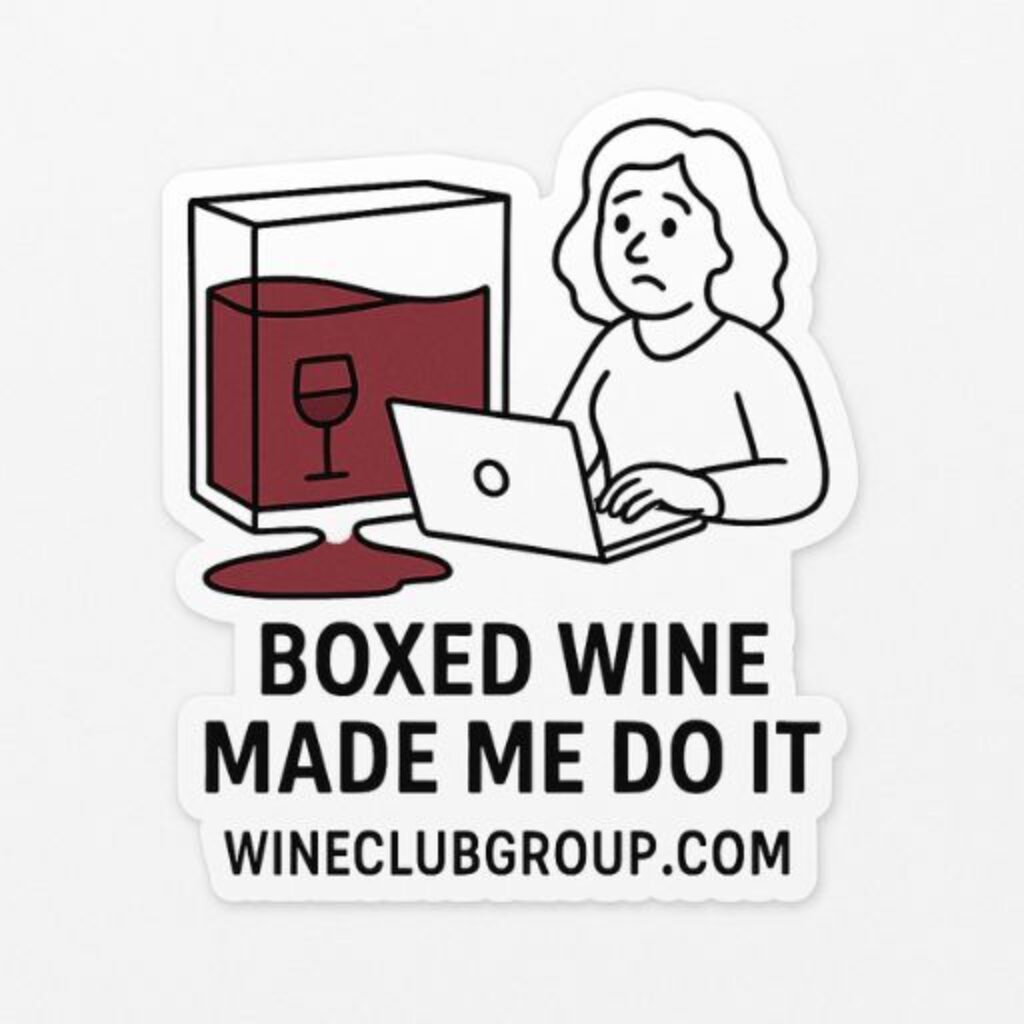
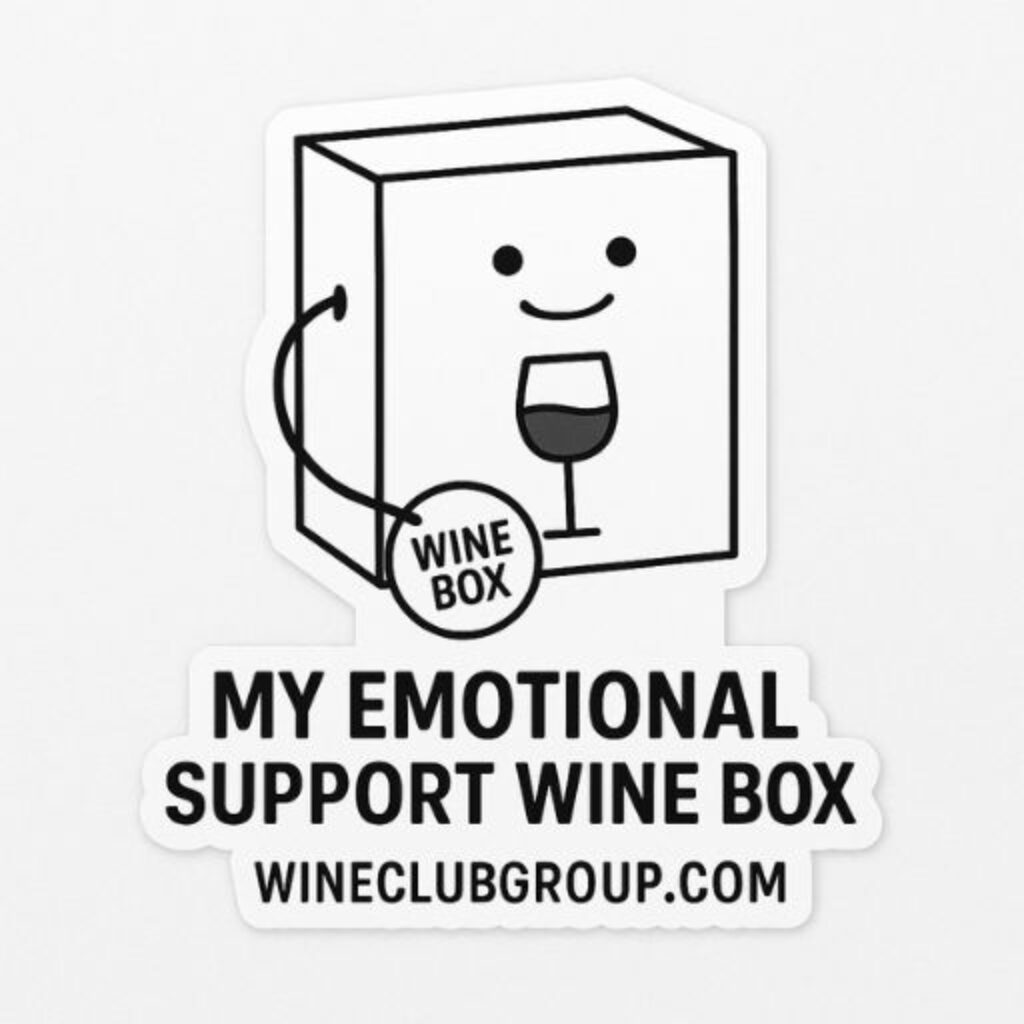
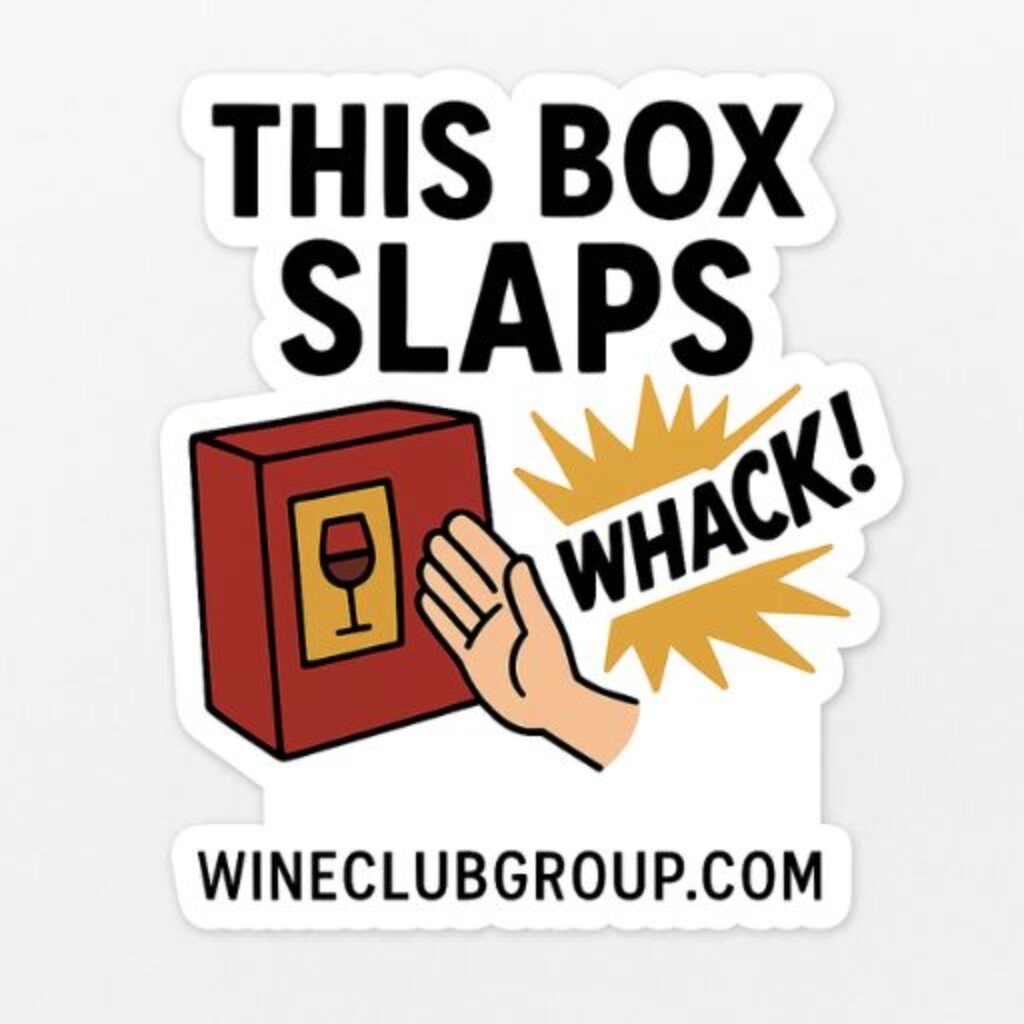
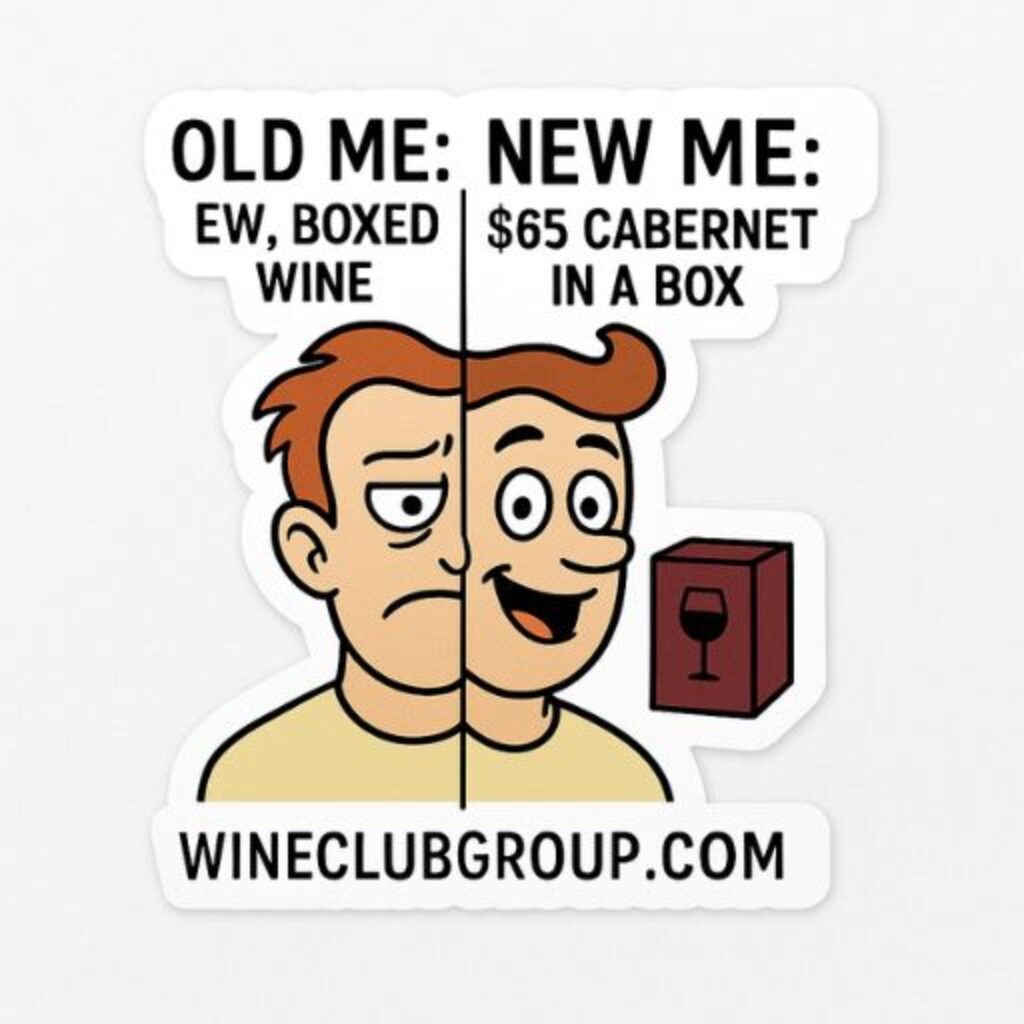

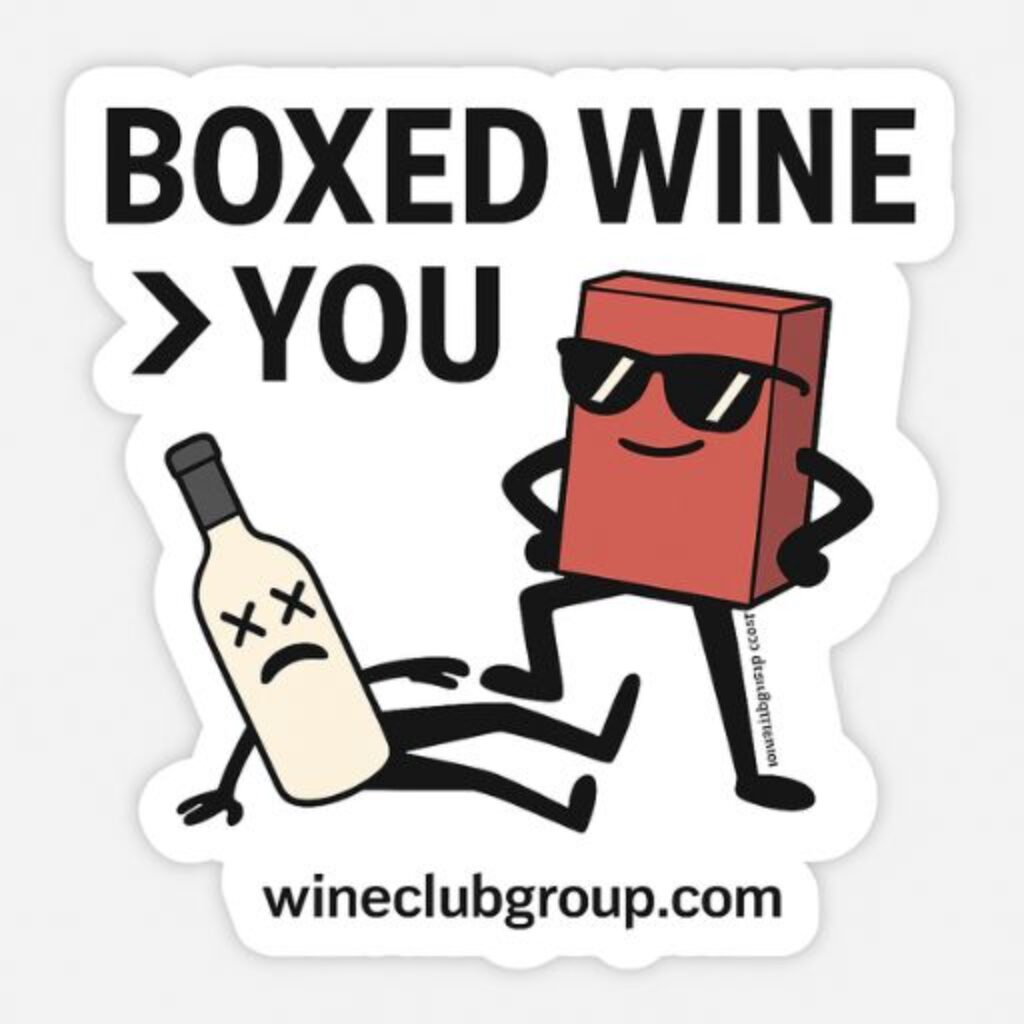
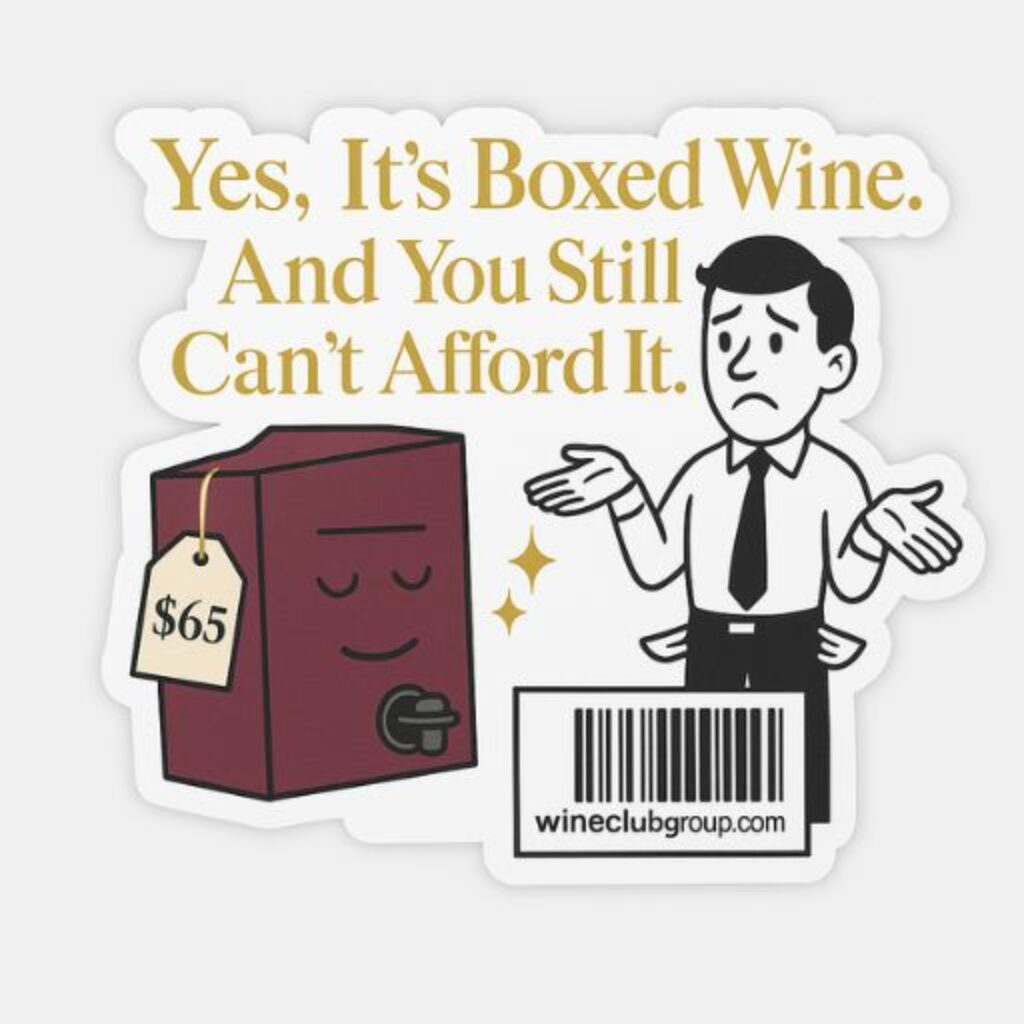
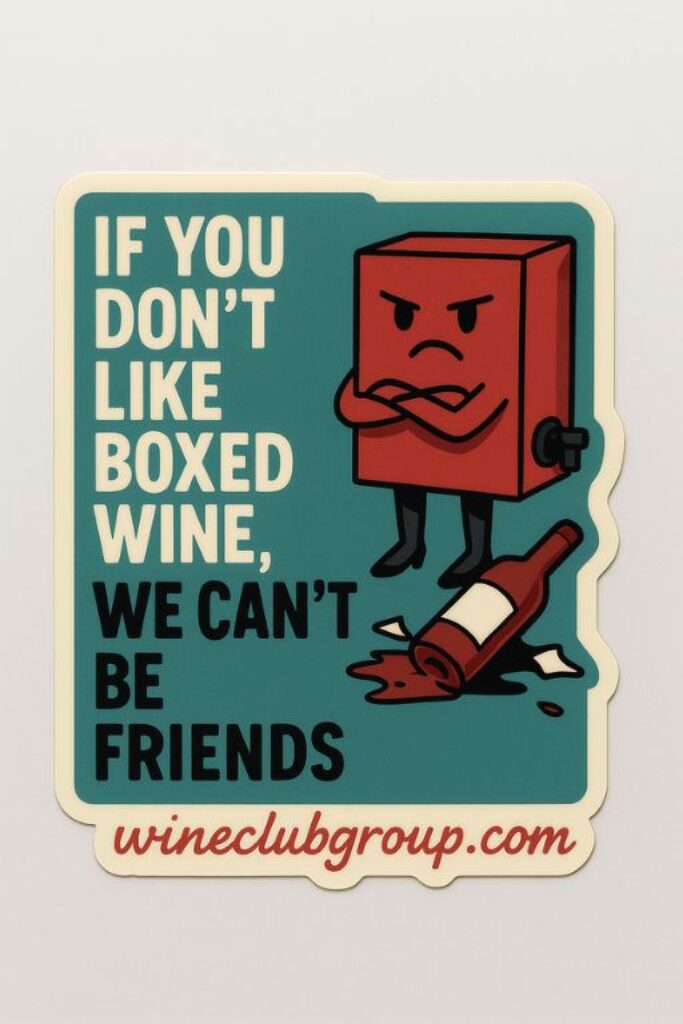
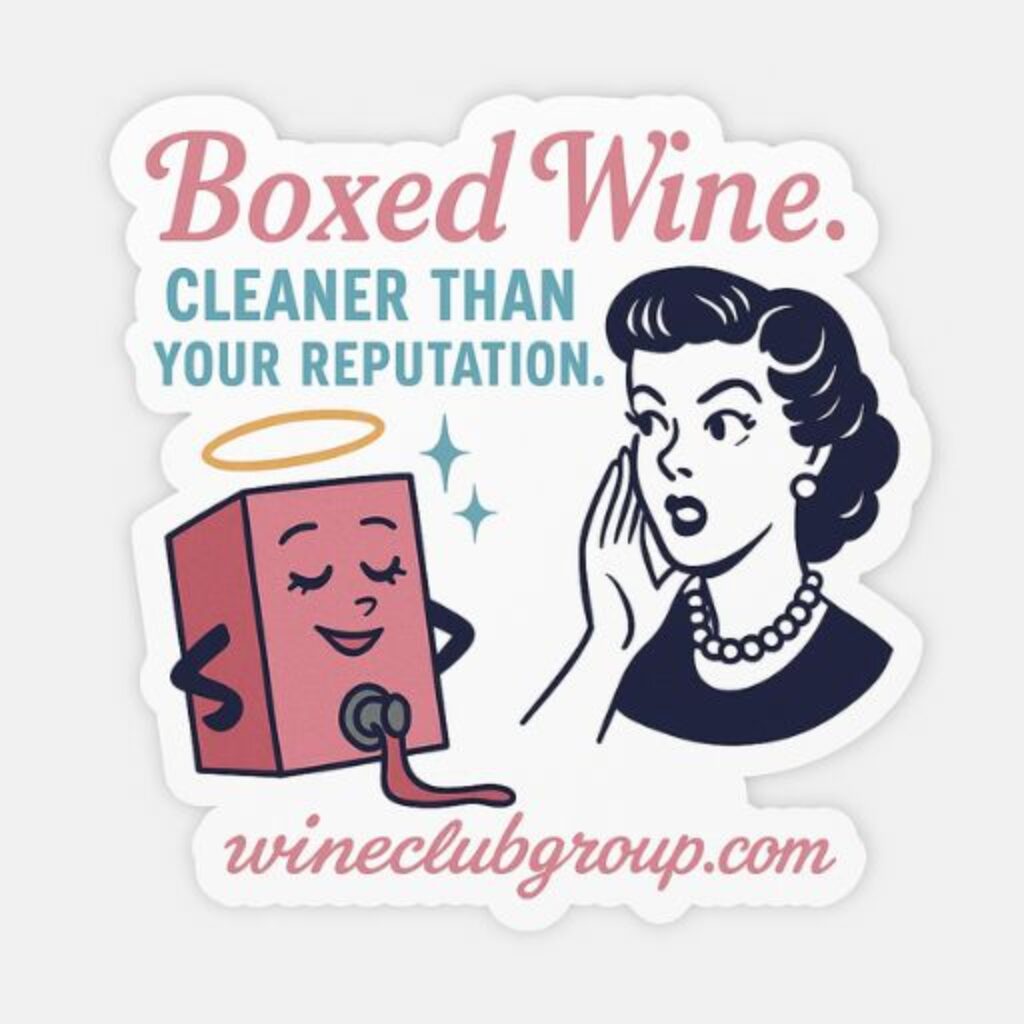
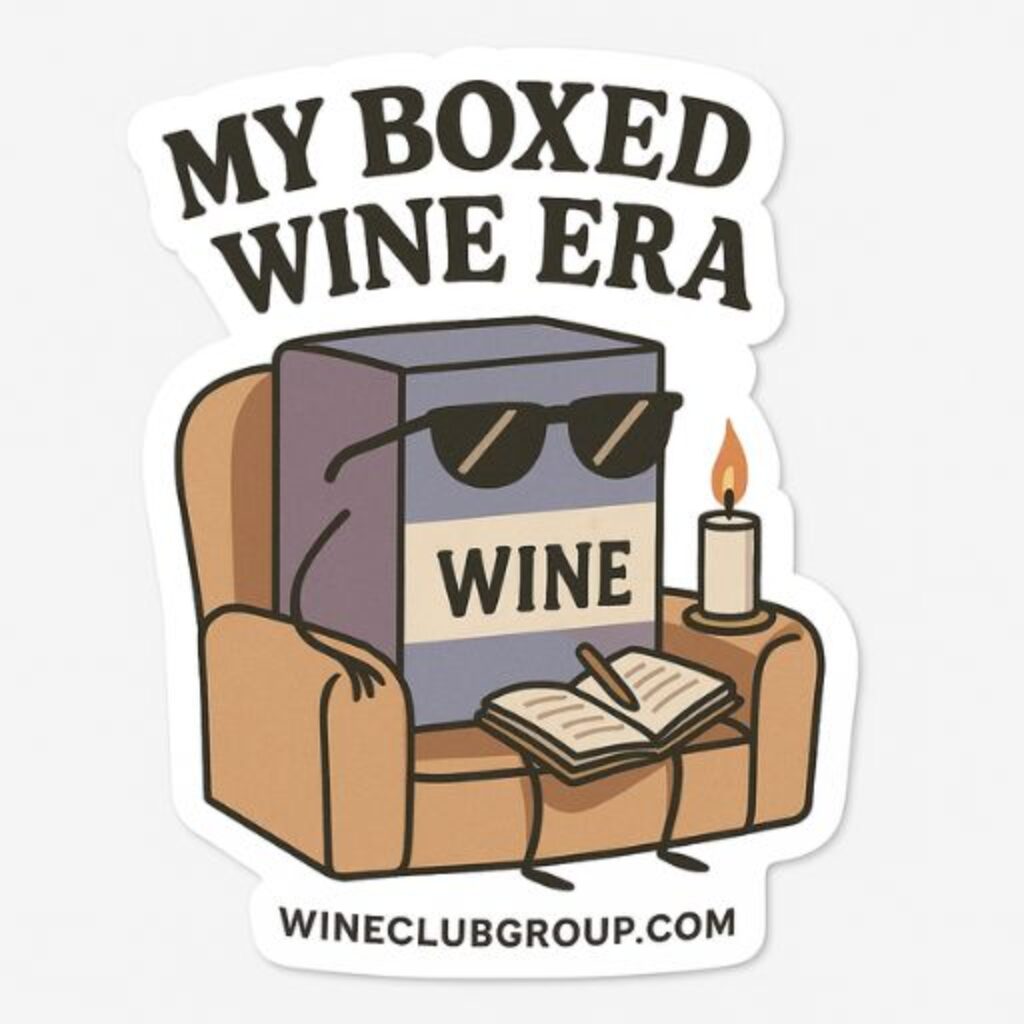
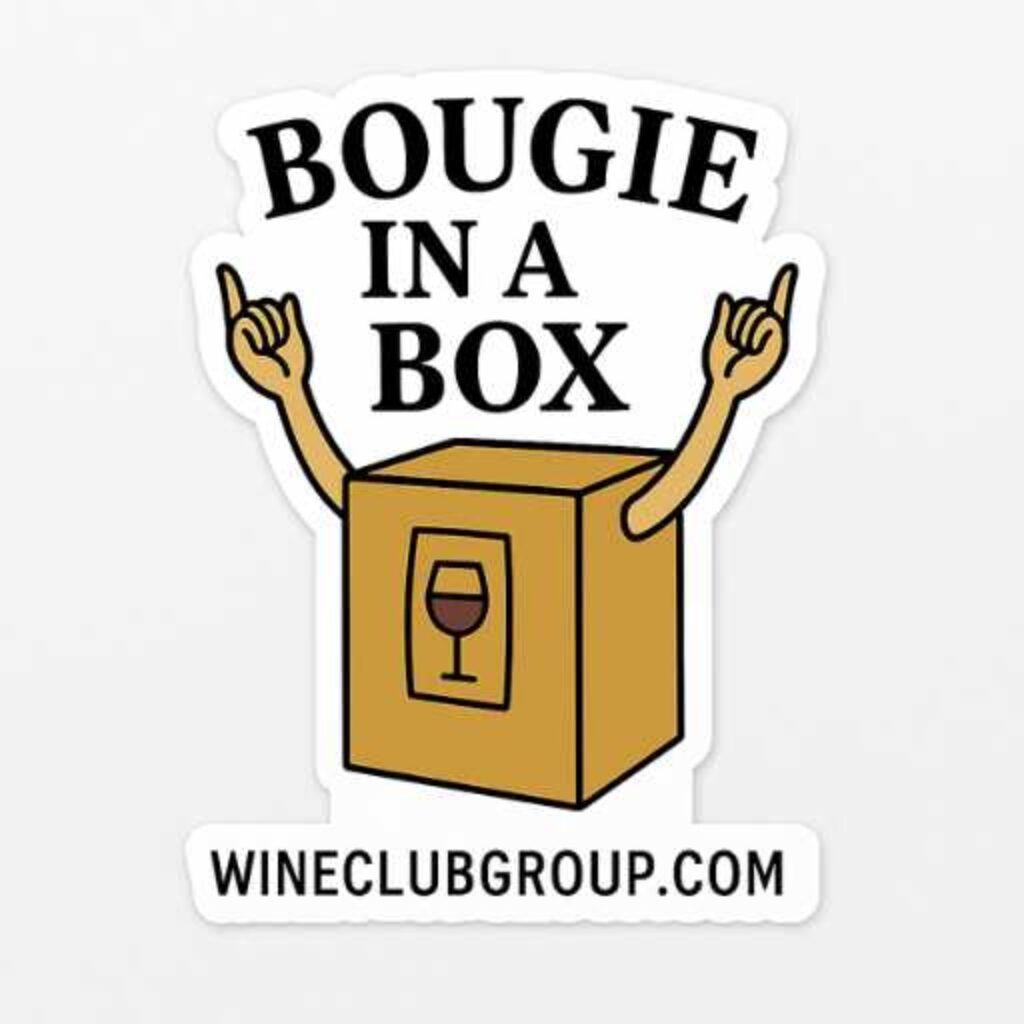
Boxed Wine FAQ
❓ Is boxed wine cheaper than bottled wine?
Yes — on a per-glass basis, boxed wine is almost always cheaper than bottled wine. A standard 3L box (equal to four bottles) often costs $20–$25, which works out to about $1.25–$1.50 per glass. Premium boxed wines are more expensive but still usually cost less than comparable bottled options.
❓ How long does boxed wine last after opening?
Once opened, boxed wine stays fresh for 4–6 weeks, thanks to its airtight spout and collapsible inner bag that prevents oxygen from spoiling the wine. By comparison, bottled wine usually lasts just 3–5 days after opening.
❓ How many glasses are in a box of wine?
- 3L box: ~20 five-ounce glasses (equivalent to 4 bottles).
- 5L box: ~34 five-ounce glasses (equivalent to 6.5 bottles).
This makes boxed wine one of the most efficient ways to stock up for parties or casual drinking.
❓ Is boxed wine good?
It used to be dismissed as “cheap wine,” but today’s boxed wine brands range from budget-friendly to truly premium. Options like Black Box and Bota Box offer good everyday value — but they're cheap, so keep your expectations in line. However, boutique producers like Really Good Boxed Wine and Gratsi deliver high-quality wines that rival expensive bottles.
❓ Can boxed wine be shipped to all states?
Not all states allow wine shipping due to alcohol laws. Most boxed wine brands available online, like Really Good Boxed Wine or Gratsi, will show you at checkout whether shipping to your state is permitted. Always check local restrictions before ordering.
❓ Is boxed wine eco-friendly?
Yes — boxed wine has a lower carbon footprint than bottled wine. Boxes are lighter, easier to ship, and generate less packaging waste. Brands like Gratsi and Bota Box emphasize this eco-friendly advantage.
❓ What’s the best boxed wine brand?
It depends on what you’re looking for, but the short answer is found in our reviews. We prefer Really Good boxed Wine and Gratsi.
- Budget: Franzia (super cheap and if you don't care what they drink, it's an option).
- Everyday drinking: Black Box, Bota Box.
- Premium: Really Good Boxed Wine, Gratsi.
Final Thoughts & Recommendations
Boxed wine has come a long way from its bargain-basement beginnings. Today, it’s an option that’s not only affordable and convenient but also fresh, sustainable, and — in the case of some producers — truly premium.
If you want to explore the very best of what boxed wine has to offer, we recommend starting with two standouts:
- Really Good Boxed Wine — Premium, vineyard-driven wines crafted to rival boutique bottles. Perfect for wine lovers who care about quality and value.
- Gratsi Wine — Eco-friendly, low-intervention wines that bring a European flair to the boxed format. Ideal for modern, sustainable lifestyles.
Both deliver straight to your door, giving you access to premium boxed wine without the markup of bottled alternatives. Whether you’re looking for everyday drinking, eco-friendly options, or a unique gift, these online-first brands prove that boxed wine is more than just convenient — it’s worth celebrating.



